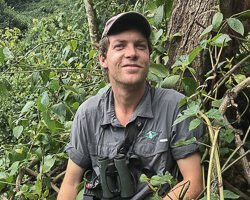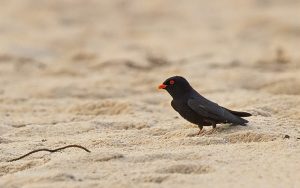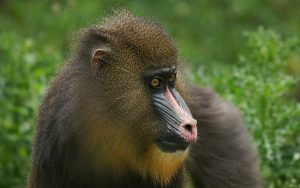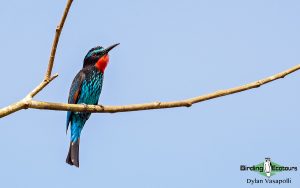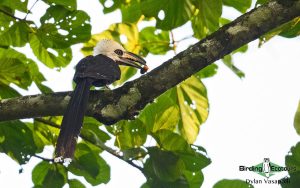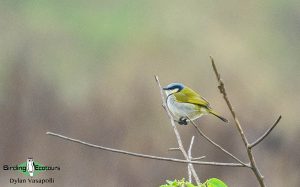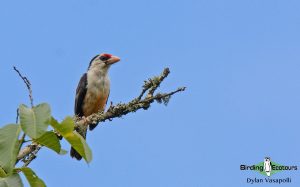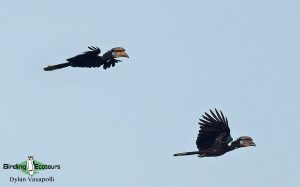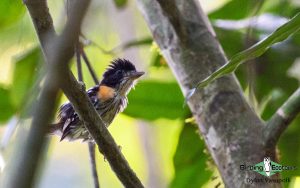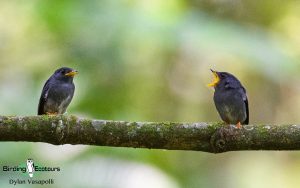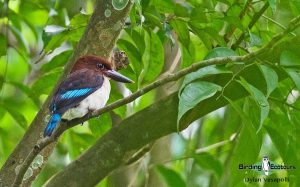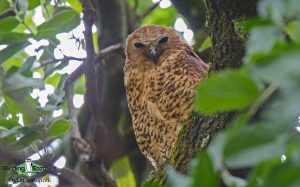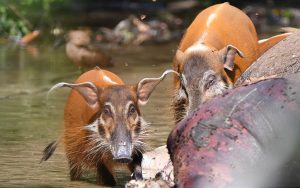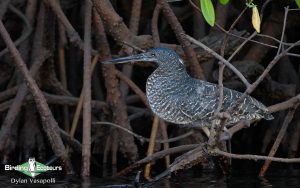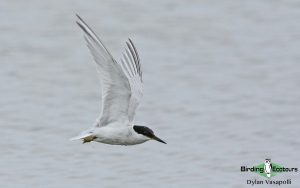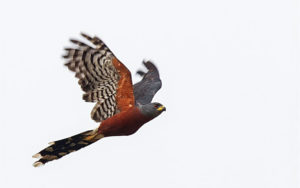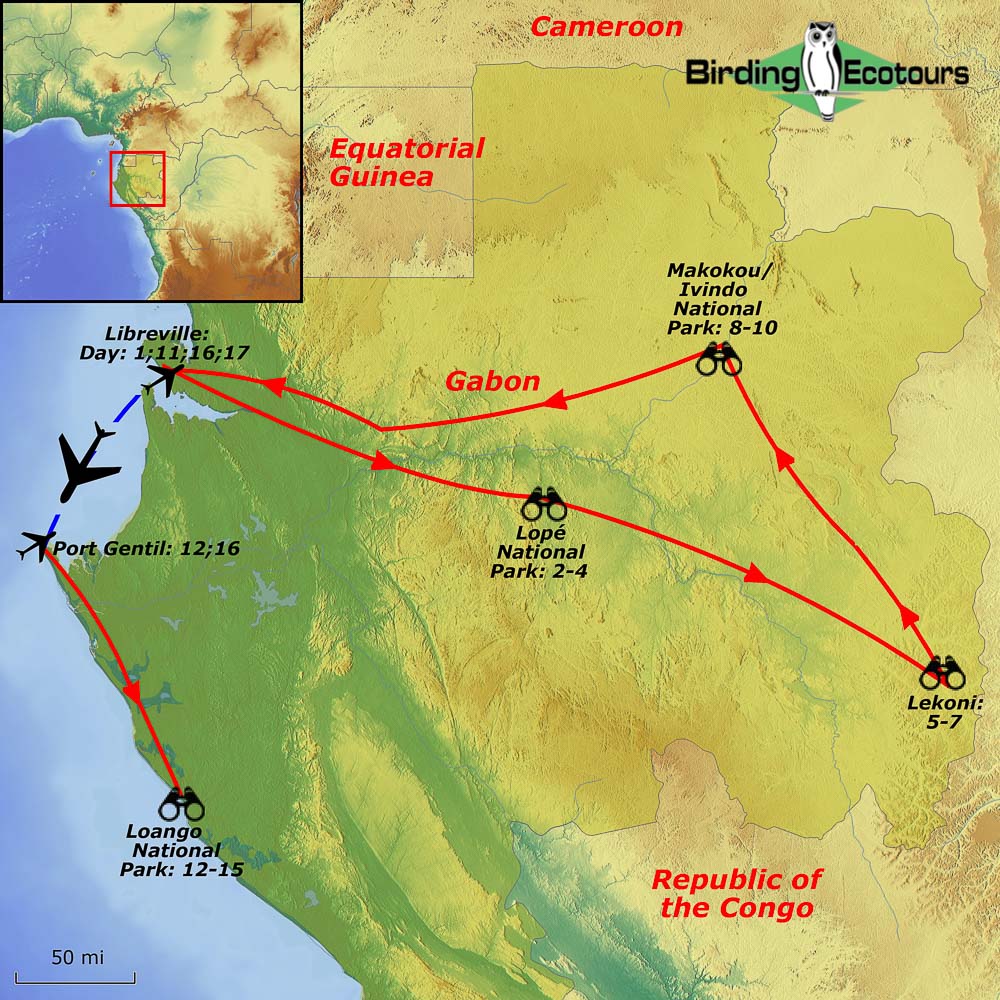Birding Tour Gabon: Complete Gabon — Rare Birds and Apes
Go to: Gabon Birding Tours | Birding Tours in Africa | All our birding tours
Complete Gabon: Rare Birds and Apes
August 2025
Gabon is a relatively undiscovered gem and hosts a great many difficult African bird species. This French-speaking country is located in Equatorial West Africa and complements our “bulge of Africa” tours much further to the north-west (Ghana being the usual destination we run in that part of the world, along with Senegal). While Gabon has no endemic birds, there are several tantalizing species such as African River Martin, Rosy Bee-eater, Vermiculated Fishing Owl, and various other Congo-basin species that are arguably more easily found here than anywhere else.
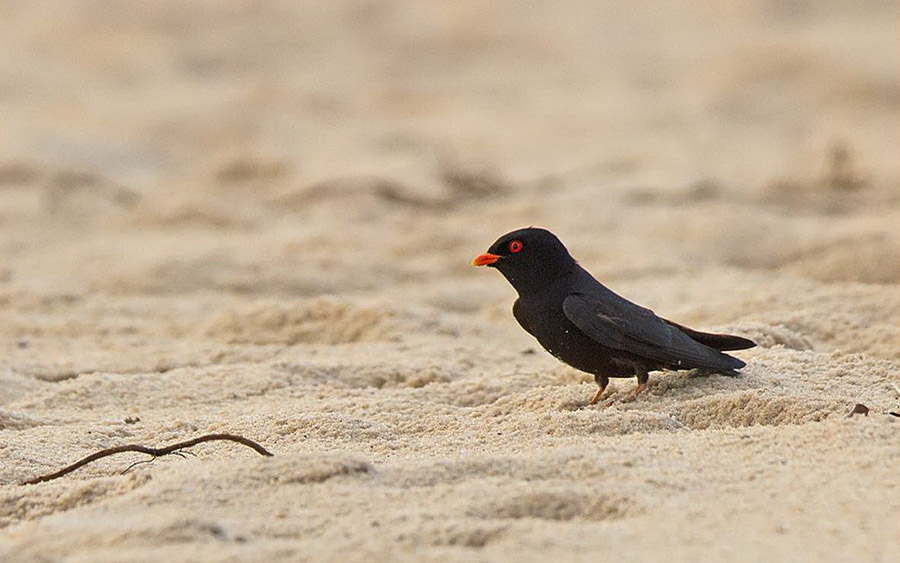
Almost 70 percent of Gabon is still covered by pristine, primeval lowland rainforest, which is part of the appeal, and, with a country population of just 1.5 million people, these forests remain relatively untouched. The country also has a wide range of other habitats, not only tropical rainforest but also coastal lagoons, pristine beaches, large rivers and associated riverine vegetation, montane-type grasslands, and broken miombo woodland, all of which are home to a wide variety of fabulous birds. Gabon also boasts spectacular animals, and these still relatively untouched wildernesses (such as within the amazing Loango National Park, and the vast Lopé National Park) are home to the likes of(African) Forest Elephant, the striking Red River Hog, three species of crocodile, Western Gorilla and the iconic Mandrill, amongst others.
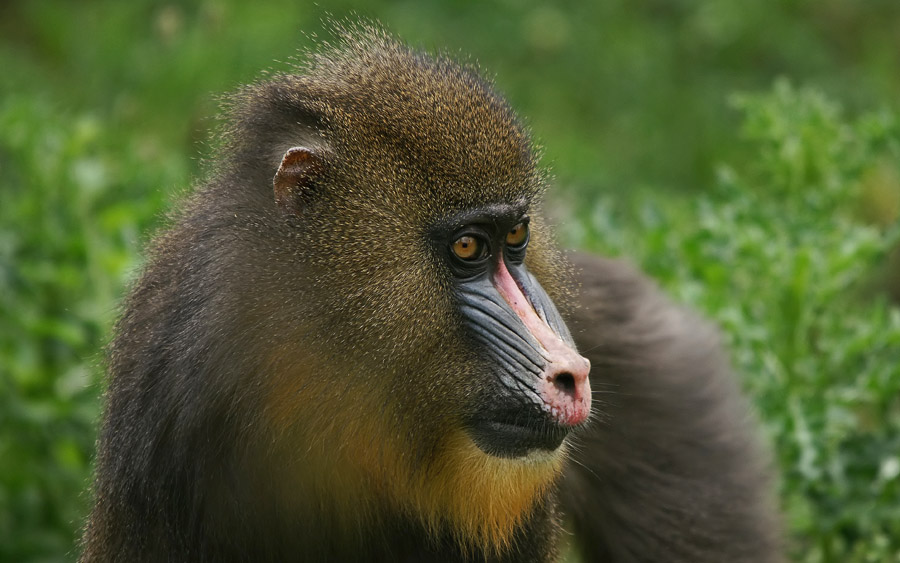
– with Mandrill trekking permits included in the cost of the tour (photo Hans Hillewaert- Wikimedia Commons).
Our well-designed, comprehensive Gabon tour visits all of the key birding sites and targets a great deal of the country’s many specials. Beginning in the coastal capital city of Libreville, we transit inland firstly to forested Lope National Park, followed by the wild open expanses of the Lekoni region and the Bateke Plateau, before moving onto the extremely wild and largely untouched forests of the greater Makokou area. The bulk of our birding will be lowland-forest-based birding, however, we will also ensure we explore some of the grasslands and associated woodland environments for a fine change. Among the many possible species, we hope to find such prized birds as Black-headed Bee-eater, Dja River Scrub Warbler, Congo Serpent Eagle, and Congo Moor Chat, amongst many other Congo-basin species, more easily sought here than anywhere else in their range. We then transit back to Libreville, and take a short domestic flight to the coastal wetlands, rivers, and surrounding forests of the greater Loango National Park. We conclude our tour here, seeking out the country’s more well-known specials, such as African River Martin and Rosy Bee-eater, along with others such as the rare Vermiculated Fishing Owl.
Unique to our tour are the unparalleled opportunities to see both Mandrill and Western Gorilla – for both of which we specially dedicate time to seeing and trekking on our tour.
Itinerary (17 days/16 nights)
Day 1. Arrival in Libreville
Today is your arrival day, and you are welcome to arrive at your leisure (there are no formal plans for birding today). Following your arrival into the Gabonese capital of Libreville you will be transferred to your hotel, where the tour will begin with a group dinner.
Overnight: Libreville hotel
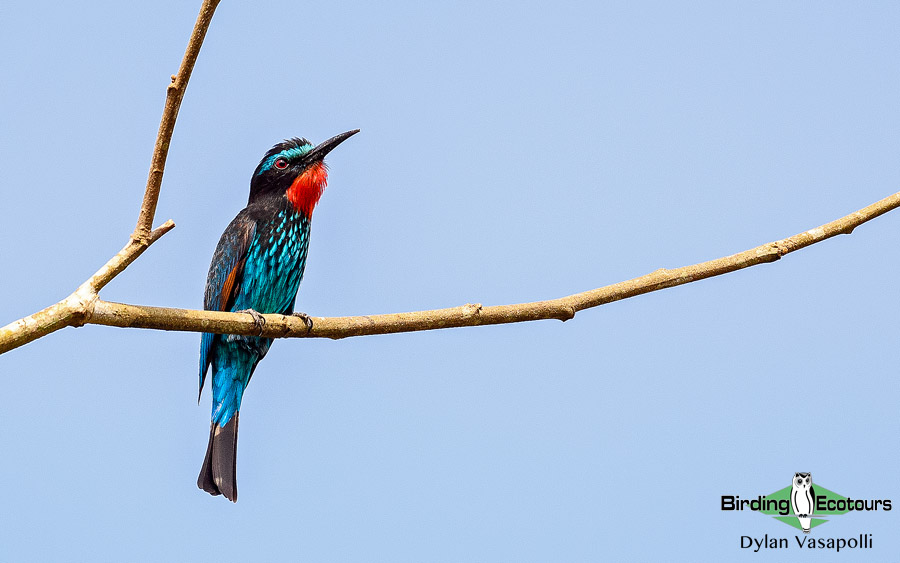
Days 2 – 4. Birding Lopé National Park
We have a long transfer on Day 2, as we head for Lopé National Park, where we will spend three nights.
We will have two full days to explore Lopé National Park (along with some time during the afternoon of Day 2 as well). This is one of the biggest national parks in Gabon, offering a mix of rivers, bush savanna, open plains, and forest. Given the size of the reserve we will only be able to cover a fraction of it; however, we will access some of the most exciting areas in the reserve. In the open areas we will try for species such as Senegal Lapwing, Blue-breasted Bee-eater, Compact Weaver, and Red-headed Quelea, while arguably our biggest target will be the localized Dja River Scrub Warbler. In the forest and at the forest edges we will seek out Long-tailed Hawk, Red-chested Owlet, Lyre-tailed Honeyguide, and the superb White-crested Hornbill, among other more common species, while the rivers will see a suite of species likely, including White-crowned Lapwing, African Skimmer, and Rock Pratincole. Bat Hawks are also regular over the rivers in the evenings. We will also be sure to keep an eye to the sky for the sought-after Bates’s Swift.
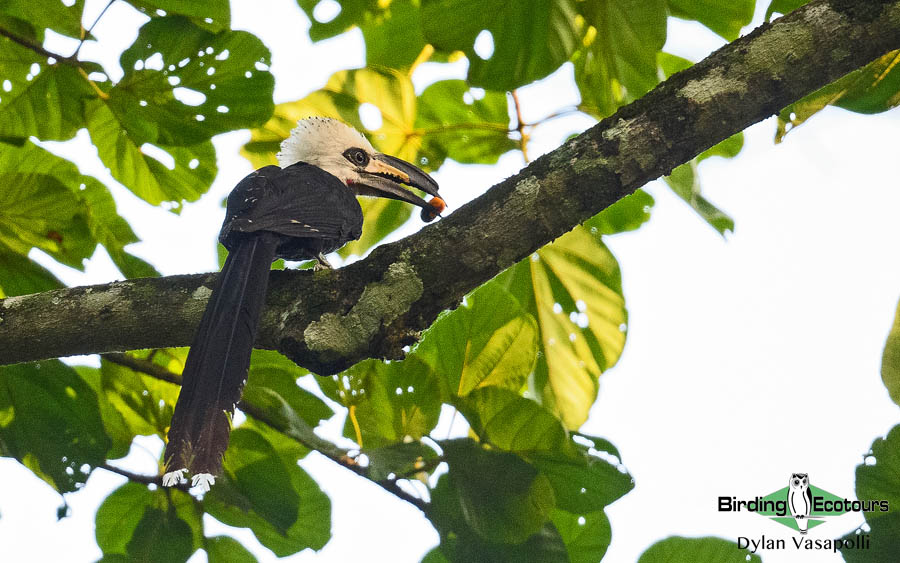
The scarce Grey-necked Rockfowl does occur in the area; however, during the dry season (when we run this tour) it is rare and nearly impossible to see, and is perhaps more easily sought on our Cameroon tour, or in the wet season during January and February (we can arrange tours by special request). As such, we will not focus on this species during this tour. Amongst the many birds present here, we will watch out for Red-billed Dwarf Hornbill, Speckled Tinkerbird, African Shrike-flycatcher, Red-bellied Paradise Flycatcher, Brown-throated Wattle-eye, Western Black-headed Batis, Red-eyed Puffback, Fiery-breasted Bushshrike, Lowland Akalat, Yellow-lored Bristlebill, Chattering and Croaking Cisticolas, Lemon-bellied Crombec, Fraser’s Forest Flycatcher, Grey Tit-Flycatcher, Vieillot’s Black and Dark-backed Weavers, Splendid Starling, Superb and Reichenbach’s Sunbirds and Quailfinch.
Not only is Lopé home to many bird species but also to populations of (African) Forest Elephant and African (Forest) Buffalo, along with a wide variety of primates, including Putty-nosed, Crowned, and Moustached Monkeys, Grey-cheeked Mangabey, Black Colobus – and most importantly, the rare and stunning Mandrill.
*We have a special activity set aside, where we undertake to track and see Mandrill within Lopé. Please note that this half-day activity is included in the tour cost.
Overnight: Lopé National Park
Day 5. Transfer from Lopé National Park to Lekoni
We will depart the fantastic Lopé National Park bound ultimately for Lekoni, a small ‘town’ in the south-eastern parts of Gabon – however, we will only reach Franceville tonight (a short hop away from Lekoni). This is a long transfer; we will be departing in the morning, and only arriving very late in the afternoon, with limited time for birding along the route.
Overnight: Franceville hotel
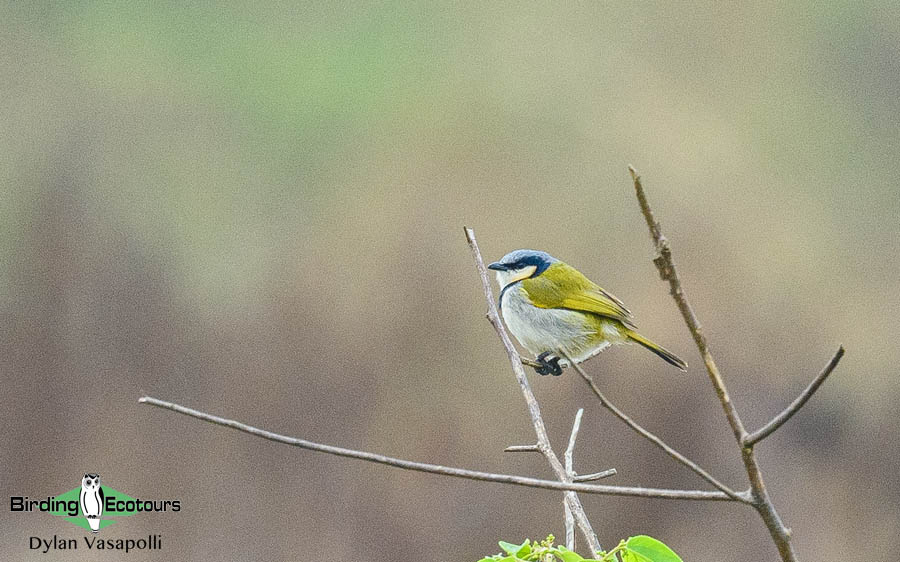
Days 6 – 7. Birding Lekoni and surroundings
The area around Lekoni is rather unique in equatorial Africa – comprising of most notably the higher-lying grasslands of the Batéké Plateau – a habitat zone that seems very much out of place here. Naturally, this somewhat isolated habitat hosts many unique bird species, not found elsewhere in Gabon and more characteristic of further south in Africa – such as parts of Angola and Zambia. In addition to these montane-type grasslands there are also small tracts of somewhat-stunted miombo woodland along with patches of montane forest, creating a fantastic birding environment! Arguably the most prized bird of the grassland zone is the sought-after Congo Moor Chat, which is relatively common and normally fairly conspicuous. However, not to be outdone are other sought-after species such as Finsch’s Francolin, Black-rumped Buttonquail, White-bellied Bustard,Flappet Lark and the unique local form of Rufous-naped Lark, the prized Black-collared Bulbul, Fawn-breasted Waxbill, and Short-tailed Pipit.
Where the grasslands give way to miombo-type woodlands we will focus on other species, such as the prized Black-headed Bee-eater, Black-backed Barbet, Black Scimitarbill, Gorgeous Bushshrike, Red-capped Crombec, Yellow-bellied Hyliota, Tinkling Cisticola, Green-capped and Salvadori’s Eremomelas, White-winged Black Tit, Souza’s Shrike, Western Violet-backed Sunbird, Wood Pipit, Cabanis’s Bunting, and the rare and localized Black-chinned Weaver. We will also be sure to visit a few of the montane forest patches present in the area, and here we will search for species such as African Broadbill, Black Bee-eater, Blue-throated Roller, Angolan Batis, Bocage’s Bushshrike and Snowy-crowned Robin-Chat, amongst others.
Overnight: Lekoni guesthouse (basic)
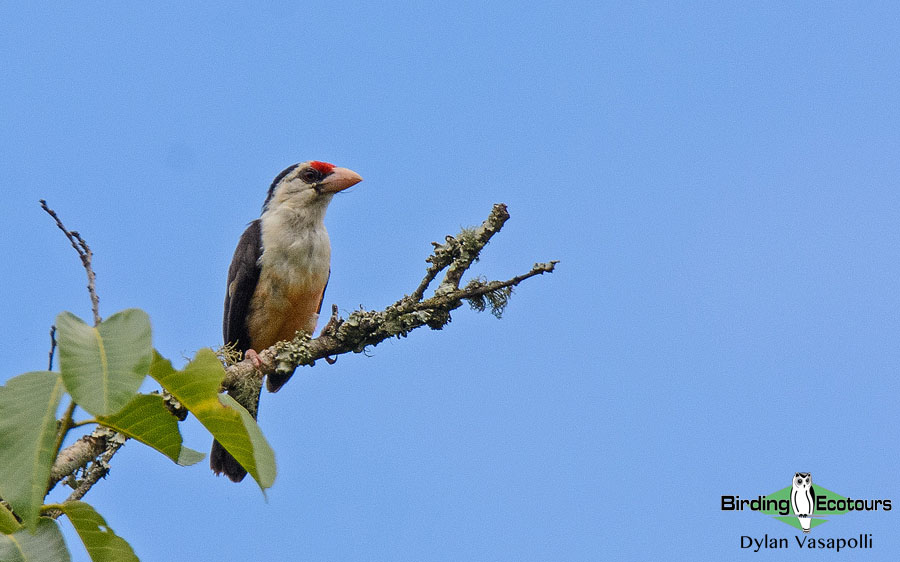
Day 8. Transfer from Lekoni to Makokou
Following the Lekoni area, our next major birding destination is the impressive forests of the greater Makokou area (which includes the vast Ipassa Strict Nature Reserve/Ivindo National Park, and surrounds).This is another very long drive, with limited birding available along the way – though well worthwhile as we access some of the most pristine tracts of Congolese lowland forest available. The sought-after Red-throated Cliff Swallow breeds under some of the culverts on the route and will be one of our main targets.
Overnight: Makokou hotel
Days 9 – 10. Birding the greater Makokou area
We have two full days of birding, in which to explore and try to find as many of the exciting species that exist here as possible. Our time will be divided between the Ipassa-Makokou Strict Nature Reserve, Ivindo National Park, and some general roadside birding along old forestry tracks in the surrounding area.Most of our birding will be done on foot as we explore and venture down some of the paths cut into the forest while investigating calling birds and bouts of activity. Naturally, forest birding can be difficult, and this area is certainly no exception; however, with patience and a bit of luck we should enjoy a number of the area’s many specials.
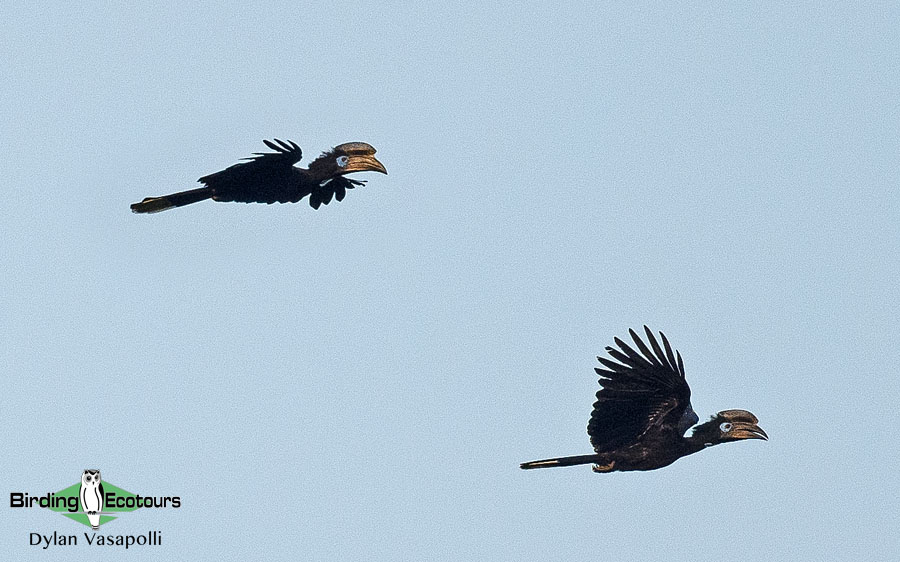
The canopy and upper levels of the forest play host to some of the larger and arguably more vocal species, and we will search for the massive Great Blue Turaco along with its more ‘normal’-sized cousins, Yellow-billed and Guinea Turacos. A plethora of Hornbills occurs here, including sought-after White-thighed, Black-casqued, Red-billed Dwarf, Black Dwarf and White-crested, while Piping and African Pied are usually more common. Chocolate-backed Kingfishers call from the upper reaches of the massive trees, yet remain as difficult to see as ever. Barbets are also well represented, and the area hosts Hairy-breasted, Grey-throated, Yellow-billed and Yellow-spotted, along with a number of tinkerbirds such as Yellow-throated and Red-rumped. The deep calls of Afep and Western Bronze-naped Pigeons ring out throughout the forest, and it normally takes some effort to track these birds down. A number of Cuckoos are also present, and our main targets will feature the sought-after Yellow-throated, along with Dusky Long-tailed and Olive Long-tailed, while more widespread species include African Emerald, Black and Red-chested. Not to be forgotten, a number of Woodpecker species also occur here, and species such as Yellow-crested, Brown-eared, Buff-spotted, Gabon and Green-backed all feature. Many passerines also frequent the higher reaches, and we’ll be keeping an eye out for Red-eyed Puffback, Western Oriole, Purple-throated Cuckooshrike, Green Hylia, tiny Rufous-crowned Eremomela, Fraser’s Rufous Thrush, Dusky Tit, Fraser’s and Little Green Sunbirds, and all of the world’s Nigritas– Grey-headed, Pale-fronted, Chestnut-breasted and White-breasted.
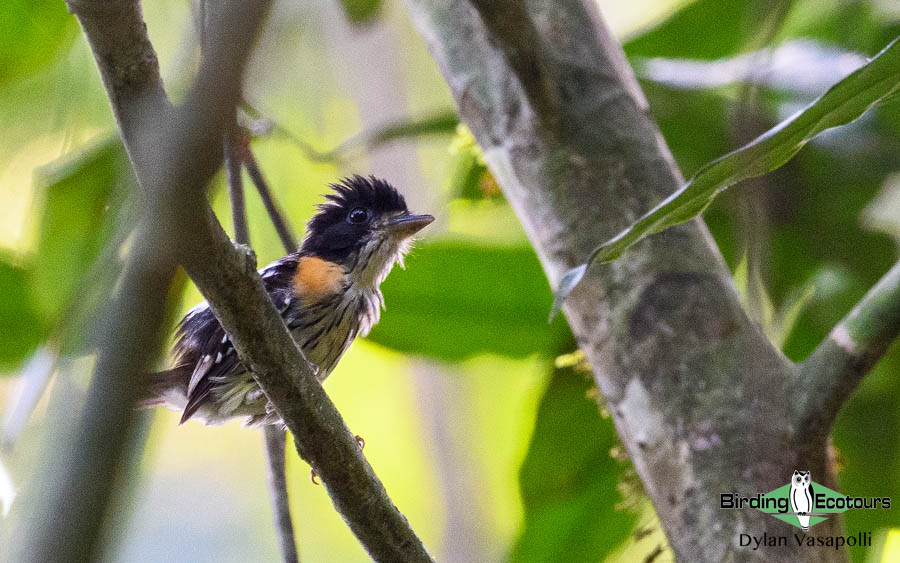
We will need to be quite fortunate, however, to come across the poorly known Spot-breasted Ibis, Plumed Guineafowl, the rare Black-collared Lovebird, the sought-after African Piculet, and the stunning Rufous-bellied Helmetshrike, along with the likes of Fernando Po Batis, Black-necked Wattle-eye, Yellow-capped Weaver, and both Rachel’s and Red-crowned Malimbes – but all are distinctly possible.
Species that prefer the mid-strata and vine tangles coming down from the canopy include the sought-after Bare-cheeked Trogon, secretive Rufous-sided Broadbill, African Dwarf and Blue-breasted Kingfishers, Blue Malkoha, Fraser’s Forest, Yellow-footed and Chestnut-capped Flycatchers, Bates’s Paradise Flycatcher, Gabon Batis, Yellow-bellied and White-spotted Wattle-eyes, Western and Yellow-throated Nicators, Yellow-browed Camaroptera, Grey Longbill, the sought-after Gosling’s Apalis, Maxwell’s Black Weaver, and Crested, Blue-billed, Red-bellied and Cassin’s Malimbes.
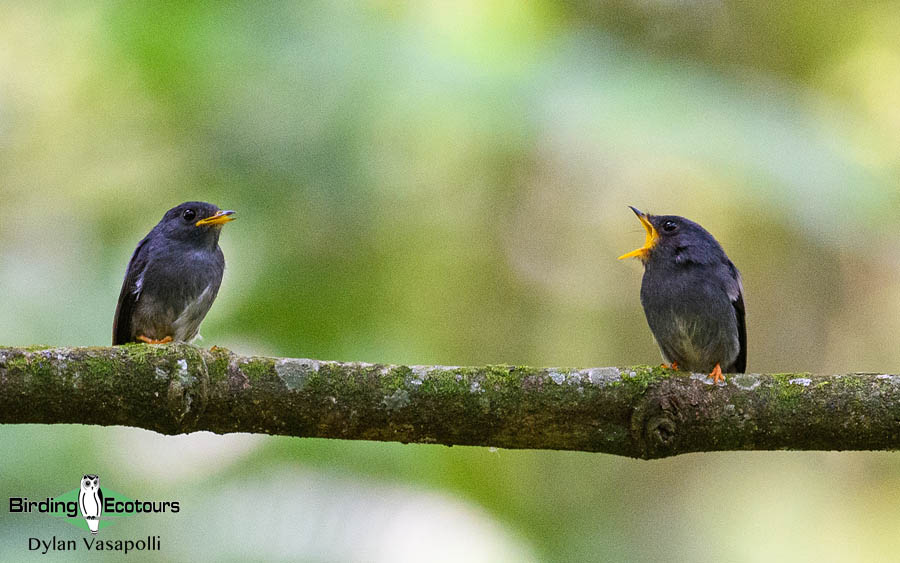
We will also be able to hone our bulbul skills immensely here, with a vast number of different species occurring within the forest, including sought species such as Sjöstedt’s, Ansorge’s, Yellow-whiskered, Falkenstein’s, Honeyguide, Golden, Spotted, Eastern Bearded and White-bearded Greenbuls, while other possible species include Swamp Palm Bulbul and Little, Slender-billed, Little Grey, Plain, Simple, Icterine, Xavier’s and Red-tailed Greenbuls along with Red-tailed Bristlebill.
Tangles, thickets, and bushy growth in the lower strata down to the ground play host to shy species such as Black Guineafowl, White-spotted Flufftail, Blue-headed Wood Dove, the beautiful Forest Robin, Brown-chested and Fire-crested Alethes, Brown Illadopsis, Lowland Sooty Boubou, Olive-green Camaroptera, Banded Prinia, and both Red-tailed and White-tailed Ant Thrushes. Some of the more open areas of the forest, clearings in the forest, and forest edge zones will be searched for further species such as Scaly Francolin, Grey and Red-fronted Parrots, Gabon Coucal, the tiny Tit Hylia, Mackinnon’s Shrike, Black-and-white Shrike-flycatcher, White-chinned Prinia, Dusky-blue Flycatcher, and the secretive Woodhouse’s Antpecker.
Keeping an eye out for raptors is likely to produce species such as Cassin’s Hawk-Eagle, Congo Serpent Eagle, Long-tailed Hawk, Red-thighed Sparrowhawk and Red-chested Goshawk. These are also great areas to scan the skies for aerial feeders, and we will be on the lookout for Mottled, Cassin’s and Sabine’s Spinetails and the scarce Forest Swallow along with Square-tailed Saw-wing. Flowering trees in these zones as well as in the forest proper play host to large numbers of Sunbirds, featuring Tiny, Carmelite, Grey-chinned, Collared, Blue-throated Brown, Olive-bellied and Superb.
The grassy verges to the roads and tracks in the area host a variety of colorful seedeaters, amongst them Black-bellied Seedcracker, Western Bluebill, Black-headed and Orange-cheeked Waxbills and Black-and-white Mannikin. While here, we will also try our luck for some of the prized nocturnal birds occurring here, which might include the localized Sjöstedt’s Barred Owlet, Akun and Fraser’s Eagle-Owls, as well as both Bates’s and Brown Nightjars.
Overnight: Makokou hotel
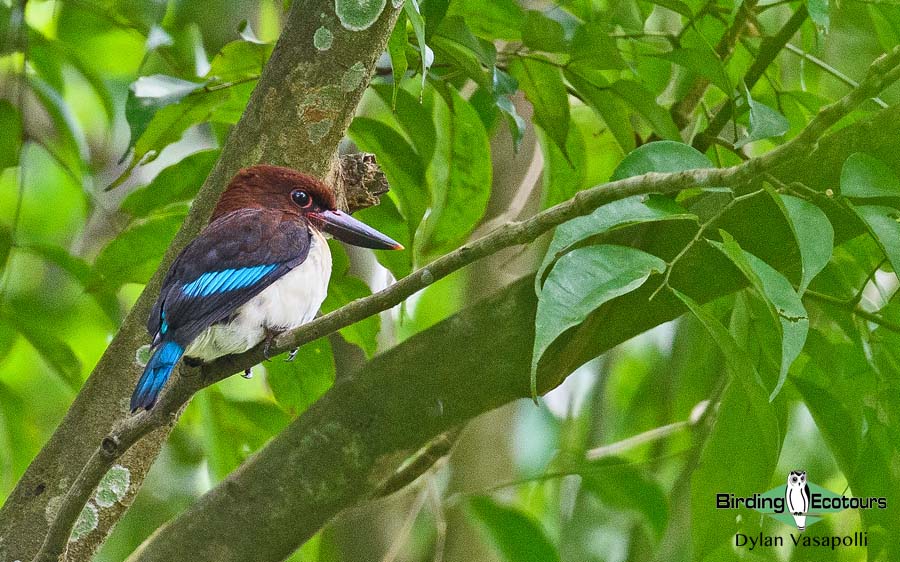
Day 11. Transfer to Libreville
After a great few days exploring the impressive forests of the Ipassa/Ivindo area around Makokou, our time in the east of the country draws to a close as we make the long trip back to the capital, Libreville, so we can prepare for the exciting conclusion of this trip in the spectacular Loango National Park. This is another very long journey that will see us getting into Libreville in the early evening.
Overnight: Libreville hotel
Days 12 – 15. Birding the lush wilderness of the Loango National Park
Saving the best for last, we transfer south (via a flight to Port-Gentil) to the magical Loango National Park, where we spend four nights.
This is one of Africa’s greatest remaining Eden’s (as quoted by Time Magazine), oozing raw Mother Nature. We will spend our time between two camps located deep within the park, giving us the best opportunities to access the excellent coastal savannas, thick riparian swamp forests and vibrant lagoons that make up this wilderness. We have several key birding targets, with arguably the most important going to the highly localized African River Martin. These rare birds arrive during the dry season to breed here – and this is the specific reason why we time our tour during this period. We will visit known colonies and spend some quality time with these strange birds. The beautiful Rosy Bee-eater also frequents these more open areas, and we can often see these two special birds alongside each other. The rarely seen Vermiculated Fishing Owl is another of our major targets for the park, and we may also be able to compare it to its equally impressive cousin, Pel’s Fishing Owl. The scarce White-bellied Kingfisher, and Loango Weaver are also to be found in the swampy wetland areas, and if we’re extremely lucky, White-crested Tiger Heron as well. If we haven’t come across them already, the forested areas here are also home to another scarce and sought-after duo – Bare-cheeked Trogon and Rufous-sided Broadbill. We will also try for the localized Violet-tailed Sunbird during our searches.
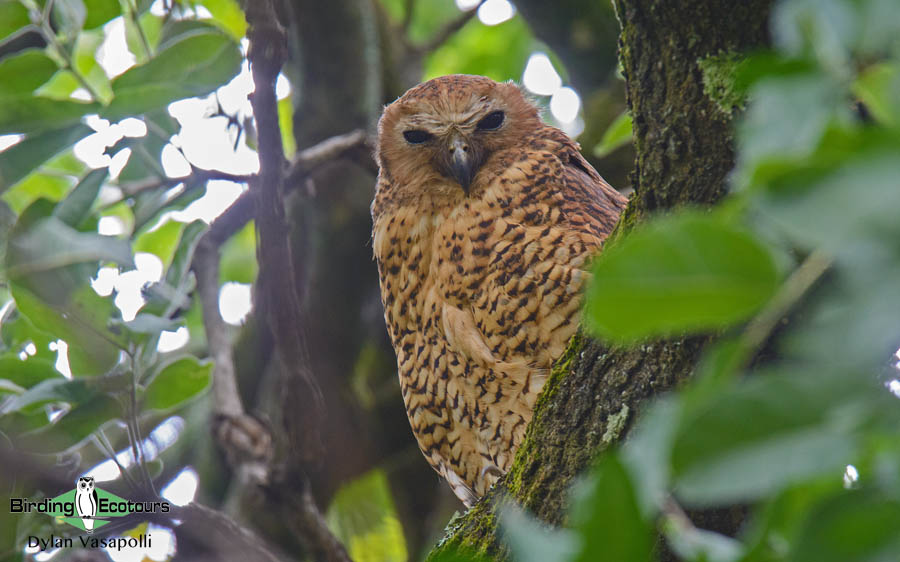
Other possible species to be found include White-backed Night Heron, African Finfoot, West African Crested and Damara Terns, White-crowned Lapwing, Forbes’s Plover, African Crake, Long-tailed Hawk, Yellow-billed Turaco, Senegal Coucal, Shining-blue Kingfisher, Blue-breasted and Black-headed Bee-eaters, Yellow-throated Tinkerbird, Black-casqued Hornbill, Yellow-billed Oxpecker (often on mammals), Snowy-crowned Robin-Chat, Grey-rumped Swallow, and Long-legged Pipit. While some of the more common and widespread species of the area include Great Egret, Woolly-necked Stork, Palm-nut Vulture, African Skimmer, Little Tern, Grey and Rock Pratincoles, White-fronted Plover, Water Thick-knee, Grey Parrot, Giant and Pied Kingfishers, Yellow-breasted Apalis, Rufous-vented Paradise Flycatcher, Swamp Boubou, and African Pied Wagtail.
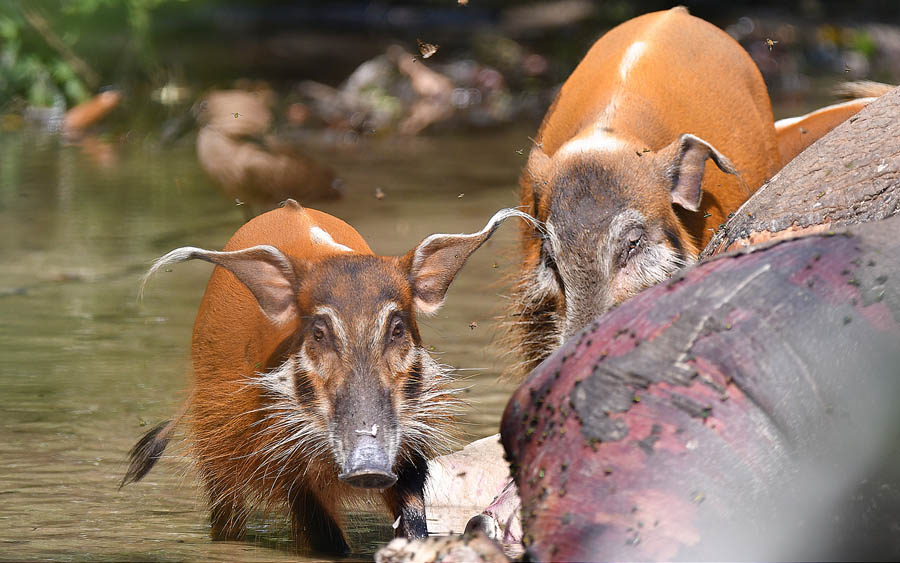
(photo Otomops- Wikimedia Commons).
Aside from the many birds we’ll be seeing, the park is arguably more famous for its other wildlife. Herds of (African) Forest Elephant roam freely, as do numbers of African (Forest) Buffalo (the smallest subspecies of African Buffalo). We will keep a special eye out for the spectacular Red River Hog and, on the waterways, Slender-snouted Crocodile. If we’re very lucky, even Leopard makes the occasional appearance.
*One of the main attractions on the mammalian front for us is the opportunity to track Western Gorillas – and we make special time on this tour for the group to not only see these rare gentle giants, but also get a deeper insight into their lives as we venture after a habituated group studied by researchers.
Overnight: Loango National Park (Akaka & Tassi Camps)
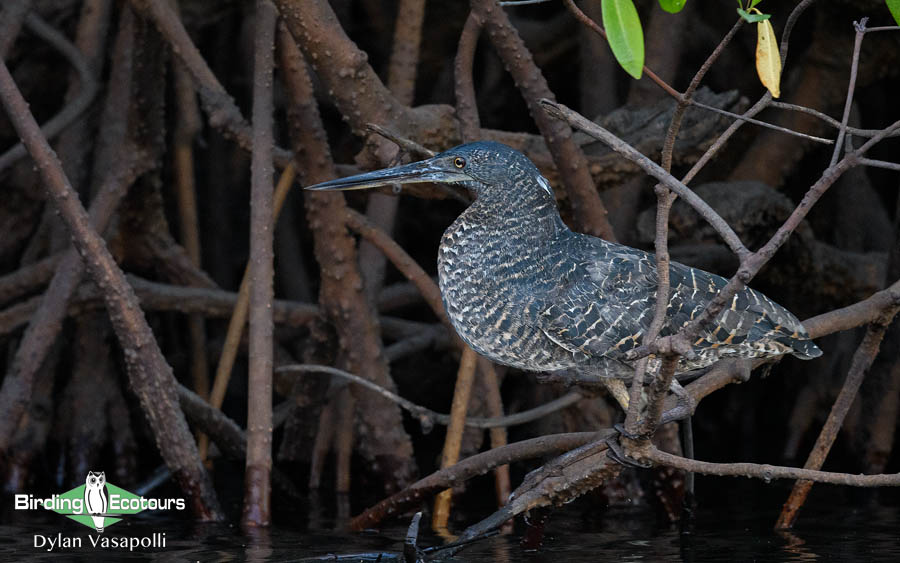
Day 16. Final birding in Loango National Park, and transfer back to Libreville
This is the last full day of the tour. We have a final morning to spend within the stunning Loango National Park, searching for any species we may not yet have seen, or enjoying our final moments with some of the iconic park species, which may include African River Martin and Rosy Bee-eater. Around midday, we will likely need to bid farewell to the park, and start our journey back to Port-Gentil, from where we will take an evening flight back to the capital, Libreville. Upon arriving at our comfortable hotel, we will settle in for one final group dinner, reminiscing about all the excellent bird and wildlife encounters we have experienced.
Overnight: Libreville hotel
Day 17. Departure from Libreville
This is your departure day, and you are welcome to leave at your leisure. Please note that there are no formal birding plans for the day, and the tour will officially conclude after breakfast.
Please note that the itinerary cannot be guaranteed as it is only a rough guide and can be changed (usually slightly) due to factors such as availability of accommodation, updated information on the state of accommodation, roads, or birding sites, the discretion of the guides and other factors. In addition, we sometimes have to use a different international guide from the one advertised due to tour scheduling.
Gabon is notoriously expensive, and from time to time we have to make quite major changes (but without adversely affecting the birding targets) to keep the prices in check to some extent.
Download Itinerary
Complete Gabon: Rare Birds and Apes Trip Report, August 2024
25 AUGUST – 10 SEPTEMBER 2024
By Dylan Vasapolli
DOWNLOAD TRIP REPORT
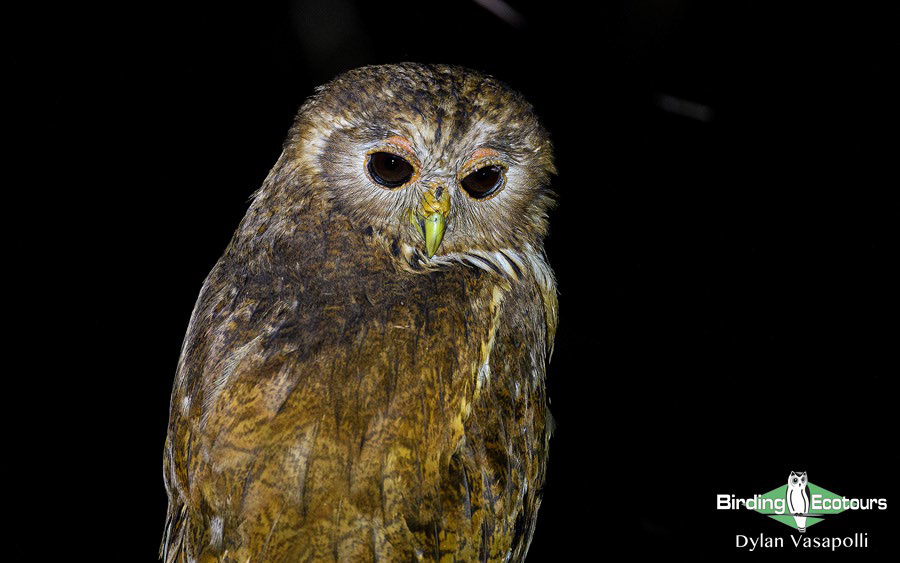
The rare Vermiculated Fishing Owl is a highly sought-after bird that is seldom seen due to its range – occupying the swamp forests of central Africa.
Overview
Gabon is one of the final frontiers in sub-Saharan African birding – and is now virtually the only place within the continent to access central African lowland areas. Formerly, many birders accessed these habitats (and their birds) through Cameroon most notably – however, safety and security have become major issues in these countries. Gabon is indeed a safe, secure, and very pristine country, and with tourism slowly opening up in the country, is sure to grow in leaps and bounds. There are very few countries where you can drive for an entire day through mostly untouched primary forest!
Not all of Gabon is unknown to the outside world – as there is its most famous park, Loango National Park, located on the coast, which Time Magazine has called “Africa’s Last Eden”. This is surely Gabon’s pride, offering high-quality lodging, superb birds and mammals, and an incredible wildlife experience. The interior of Gabon is however, more remote, basic and challenging, with roads accessing the country few and far between, making getting around a challenge.
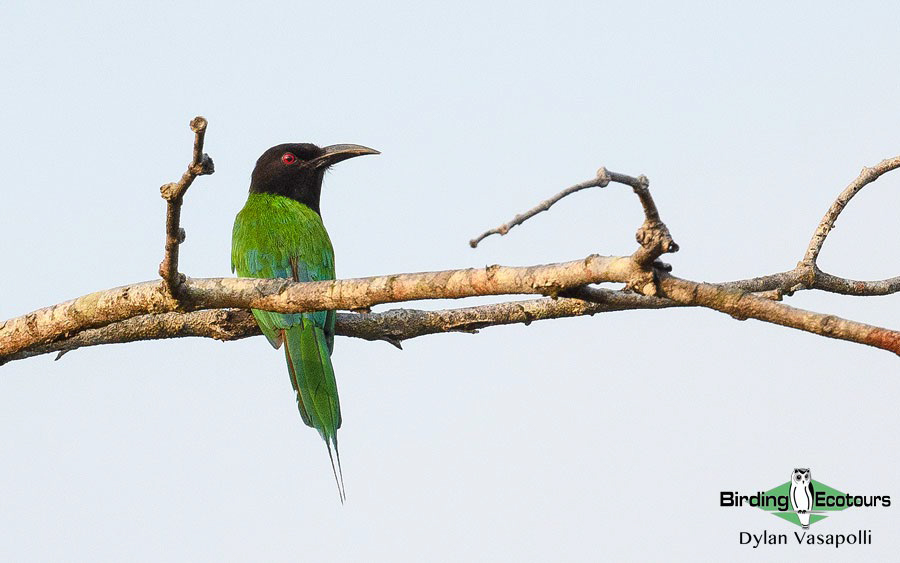
The mega Black-headed Bee-eater is one of the most sought-after bee-eaters in Africa – with its rarity and distribution often making it one of the final members of this family that birders see. We enjoyed several looks at this special and sought-after bird during this tour!
This was Birding Ecotours’ first full tour to Gabon, following a scouting tour in previous years. The tour as a whole ran very smoothly, with limited issues and troubles on the way (though in any rural African country, these can never be completely avoided). The most notable “issue” was the extreme length of all of the travel days – essentially all being 10+ hour journeys, on very rough roads, even by 4×4 standards. The birding was good generally, perhaps aided by the mostly overcast conditions, with most of the main target birds like Rosy Bee-eater, African River Martin, Vermiculated Fishing Owl, Black-headed Bee-eater and Congo Moor Chat, amongst so many others, being seen. Additionally, two important mammal targets, Mandrill and Western (Lowland) Gorilla were well seen on the tour as well – with our tour specially including activities focused on seeing and finding these rare animals.
Beginning in the capital city, Libreville, the tour headed inland to Lopé National Park, where our tour would begin with a mix of savanna and forest birding, and our wanted Mandrills – we had a dedicated Mandrill-trekking activity included in the tour. From here, we progressed farther inland to the Gabon highlands around Lekoni, where we spent a few days searching out its open-country specials. The last stop of the interior part of the tour saw us spend some time in the massive forests of the Ipassa-Makokou Strict Nature Reserve, before returning to the capital city once more. From here, we flew down to Port Gentil and concluded the tour with 5 days in and around the mega Loango National Park, capping off this tour with some excellent birds and mammals, as we explored the park’s swamp forests, forest-savanna mosaic areas and coastal wetlands. We could not have asked to end off the tour on a better note.
A detailed daily account can be read below, and the full bird and mammal lists are located at the end of the report.
Detailed Report
Day 1, 25th August 2024. Arrival into Libreville
The first day of our tour, as it is on most of our tours, is set aside as a dedicated arrival day where participants can arrive at their leisure with no formal activities taking place. Some participants arrived the previous day, while others arrived during the course of the afternoon and evening. Although the immigration into Gabon was trying, everybody arrived in one piece, though John’s bag went missing along the way (and unfortunately, going into rural Gabon with no way of getting the bag caught up with us, meant he had no luggage for the first half of the tour). I snuck out with John to get him to some “makeshift” luggage to hold him over. With all participants having arrived by evening, we enjoyed our first group dinner together as we prepared for our first long travel day.
Day 2, 26th August 2024. Libreville to Lopé
Following breakfast, we met up with our trusty drivers and hit the road, ultimately bound for Lopé National Park. We made good progress along the way to our lunch stop in Ndjole, with some common and widespread species like Palm-nut Vulture and Woodland Kingfisher seen. Some birding around the town yielded further widespread species like African Harrier-Hawk, Lesser Striped Swallow, Vieillot’s Black Weaver and Pin-tailed Whydah, while some dedicated scanning from the river’s edge gave us some distant White-crowned Lapwings, African Skimmers and Grey Pratincoles. Unfortunately, the birds were some distance away and left us wanting more, though Giant Kingfisher and lovely Orange-cheeked Waxbills gave us great looks. The road from Ndjole onwards was much worse and extremely slow going – passing through some good patches of forest and grassland mosaic habitat. Opportunistic stops gave us our first Black-casqued Hornbills, along with the scarce Bates’s Swift and a small group of Forest Swallows for some. We rolled into the comfortable La Lopé Lodge shortly after dark and settled in for the evening.
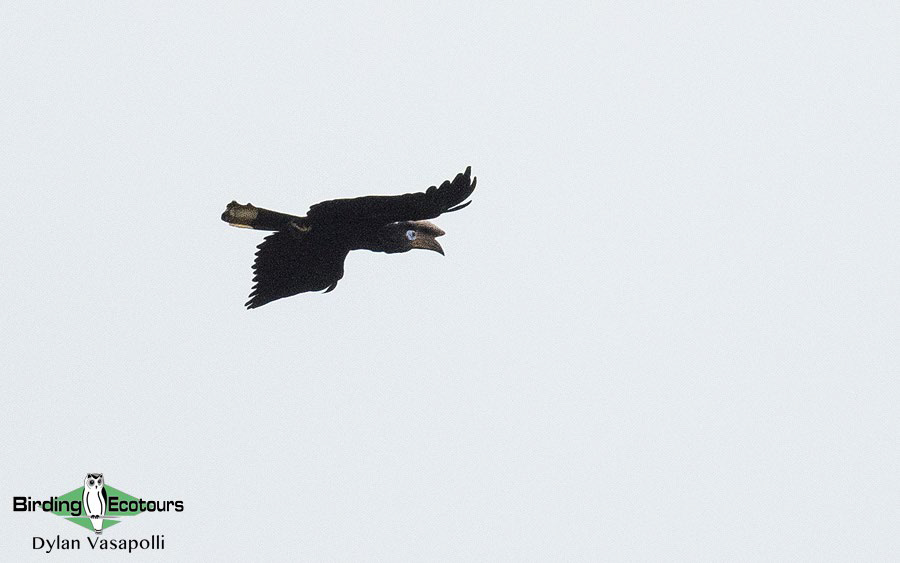
A massive Black-casqued Hornbill flew overhead.
Day 3, 27th August 2024. Birding Lopé National Park
The birding around the lodge was heaving during the early morning, and meant our breakfast was a bit truncated. Several Congo Pied Hornbills were in attendance, noisily calling from the treetops, while a flower tree was bursting with life and gave us seven sunbird species, from the tiny Grey-chinned to the more restricted Reichenbach’s and the beautiful Superb. We also did well to find our first Orange Weaver before a pair of Pale-throated Greenbuls popped out for a bit. Some commotion led us to finding a lovely Red-thighed Sparrowhawk perched up in one of the large Kapok trees. We had to tear ourselves away as we boarded our open vehicle and headed into the park for a morning birding safari drive. There was some minor frustration as our assigned guide was nowhere to be seen, but eventually we linked up, and were soon bumbling our way through the northern open grassland regions of the park. Much of the area had been recently burnt and White-throated Bee-eaters and Long-legged Pipits were plentiful. We also soon found our first herd of (Forest) Cape Buffalo – somehow these are still lumped as one species, but were numerous in the park, and we encountered many herds.
Small patches of forest break up the landscape, and we spent the bulk of our time birding within them. Lowland forests in Africa are always hard work, with these no exception. A vocal pair of Eastern Long-tailed Hornbills (formerly part of the White-crested complex) were heard early on, but were extremely shy and only some in the group were able to see them as they flitted in the dense canopies. An equally vocal Fiery-breasted Bushshrike refused to show, while Fraser’s Rufous Thrush showed exceptionally well. The forest seemed to come to life when we picked up on a Shining Drongo, as several Fraser’s Forest Flycatchers, Ansorge’s Greenbuls and Olive Sunbirds came out, before the scarce Blue-headed Bee-eater joined in on the fun. The bee-eater in particular is an incredibly difficult species in this part of its range and is infrequently seen in Gabon – making it an excellent surprise! After having gotten over the bee-eater, we veered off the pathway to try for a Blue-headed Wood Dove, which showed well, albeit briefly several times.
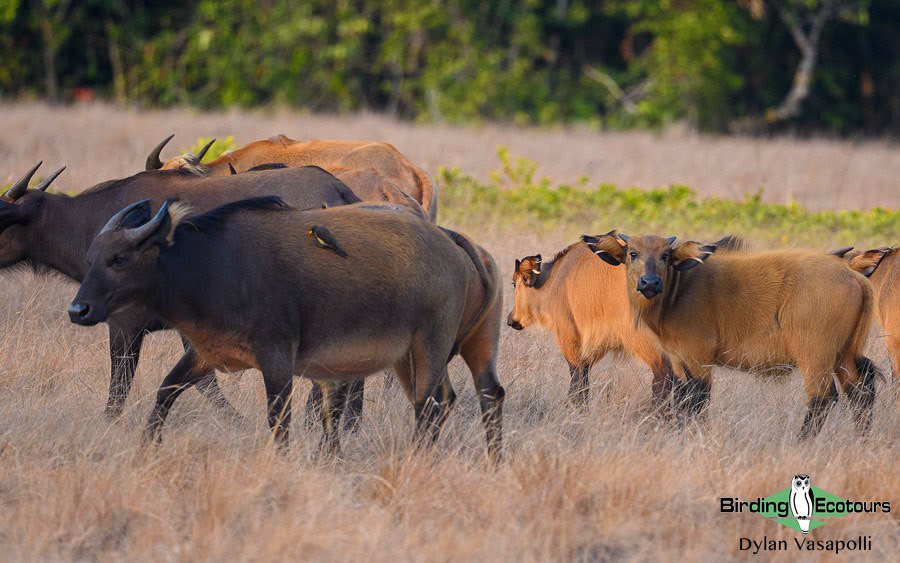
The very distinct “Forest Buffaloes” were common in the savanna parks – somehow this species is not recognized, and it is still seen as a race of Cape Buffalo.
Our final destination in the morning was a walk through to get to a small wetland where we would try for the highly localized Dja River Scrub Warbler. On cue, we heard the warbler, and it took a little while before we located the bird skulking about in some of the sedges. We also saw the bird give a few short display flights over the wetland. A fine White-bellied Kingfisher put in a surprise view here as well. With the sun shining down and the mercury high, we made our way back out the park with other species like Piping Hornbill, Grey-headed Kingfisher, Naked-faced Barbet and some Yellow-billed Oxpeckers on the buffalos. We also found our first monkeys, with several Putty-nosed Monkeys showing well, along with the scarce Black Colobus.
We took a midday break, before resuming in the late afternoon, with another drive into the park, where we would stay out until dark. We made our way to a lookout over the forests, where we scanned the surrounding trees. A few Piping Hornbills commuted up and down over the forest, as did several Grey Parrots. A Yellow-mantled Weaver came to forage in the treetops, before a flock of Chestnut-winged Starlings came through. With dusk settling, we headed over to try for the rare Bates’s Nightjar and were rewarded with some incredible views of this scarce and local species. We also found a lone Senegal Lapwing in the torch beam before exiting the park. A few cold beers capped off an exciting first full day of birding in Gabon.
Day 4, 28th August 2024. Mandrill trekking
Uniquely amongst other birding tours to Gabon, we incorporate Mandrill trekking as a dedicated tour activity. We were assigned to the morning session, and the researchers who offer this activity met us at the lodge after breakfast to take us out. There are no dedicated trackers who stay with the Mandrills at all times, and as such, they have to make use of radio telemetry to pinpoint where the animals are. This took a few attempts, but eventually we picked up on their signal, and headed off towards them. We heard them from some distance away, long before seeing them, and eventually found ourselves in dense forest, enjoying our first views of these scarce monkeys, which are virtually endemic to Gabon. At this time of year, the Mandrills form massive foraging groups, and we were taken to only a corner of the entire group, and enjoyed many animals walking about on the forest floor and up in the trees – all the while listening to their contact grunts and noises. Although we were in dense forest all the time, we had an hour to enjoy the animals, and found several large males roving through the area we could see – and enjoyed some good views. After the hour was up, we were ushered out of the forest and headed back to the lodge for a midday break. These were not the only animals we found, as we also enjoyed a fine Forest Elephant that we picked up crossing an open grassy glade nearby. On the bird front, we enjoyed repeat views of Black-casqued Hornbill, along with Grey Parrot, and others like Cassin’s Spinetail, Western Oriole, Splendid Starling and Yellow-throated Longclaw.
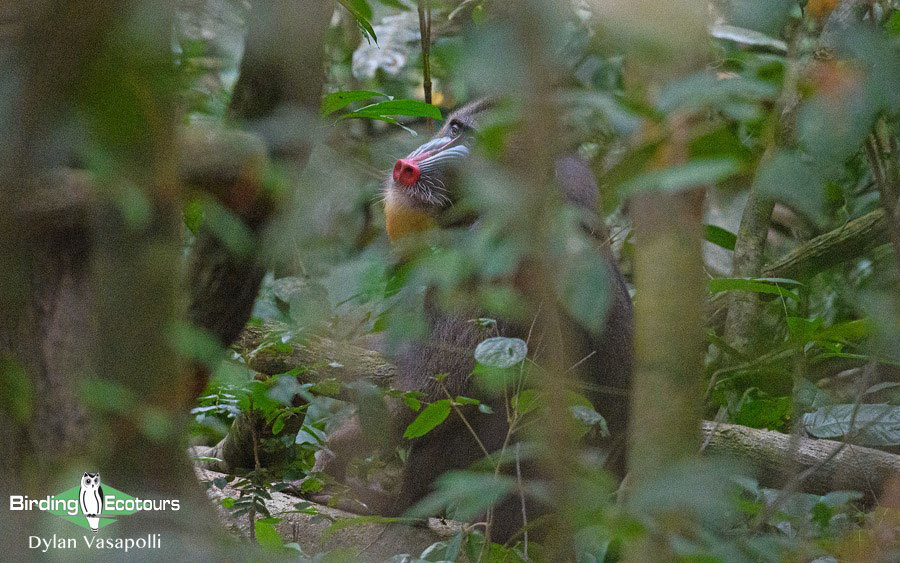
A fine male Mandrill takes a break from walking around – complete with its colorful face (and bright purple hindquarters which are not showing in this picture).
We spent the afternoon birding the area surrounding the lodge, which was again extremely birdy. A bright Diderick Cuckoo flashed by before settling alongside some African Green Pigeons and several Splendid Starlings. We moved over to the open grasslands behind the lodge, which gave us some exciting birds like Blue-breasted Bee-eater, Croaking Cisticola, Copper Sunbird and several Yellow-mantled Widowbirds. A pair of Compact Weavers were enjoyed, before we flushed up a surprising Swamp Nightjar from right in front of us. We first heard the tiny Pectoral-patch Cisticola, before we found the bird, and enjoyed some good looks as it foraged around on the ground. Dainty Bronze Mannikin and Orange-cheeked Waxbills were numerous, and we did well to find a few Red-throated Cliff Swallows in the area, alongside several other widespread species. We eventually moved over to the large river in front of the lodge, where we took it easy for a bit, dipping our feet in. Several Rock Pratincoles were seen on the many rocks lining the river, and we again got some distant views of birds like White-crowned Lapwing and African Skimmer, before a fine pair of Hartlaub’s Ducks flew by in the early evening, rounding up another good day.
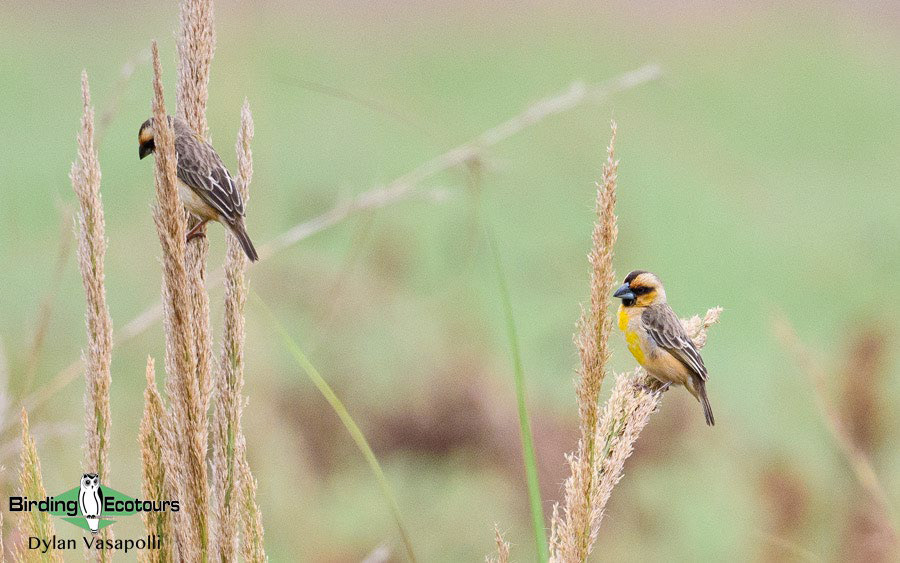
A pair of Compact Weavers showed well in the open areas near to our lodge.
Day 5, 29th August 2024. Travel to Lekoni
We had an early breakfast before hitting the road – as we had arguably the longest (and worst roads) to navigate today as we made our way to Lekoni, in the very south-east of the country right on the Republic of the Congo border. Unfortunately, just as we were getting ready to leave, a massive train pulled into Lopé town and blocked the road for a short while. Things were straightened out, and soon we were on the road again. The first half of the journey was on awful roads with little of interest seen on the way, except for Johanna’s Sunbird and a Bay Duiker. We eventually joined up onto a paved road, which made the latter part of the journey much smoother. After a long day of driving, we rolled into Lekoni at dusk, sorted out our accommodations, involving a change of venues, before enjoying another cold beer or two with dinner and calling it a day.
Day 6, 30th August 2024. Grassland and miombo birding around Lekoni
We started our morning off by heading into the mosaic of stunted woodland, grassland and mixed agricultural lands east of town. We spent as much time as possible on foot, walking through the habitat, trying to maximize the birding, and this proved a good strategy. Almost immediately after getting out the vehicle, we picked up on some weavers, and had to follow them briskly while they moved through the vegetation. We caught up with them again, and reveled in some good looks at the rare and localized Black-chinned Weaver. A bright Cabanis’s Bunting put in an appearance as well, before we found the first of several Short-tailed Pipits, which flushed up off the ground in front of us. Congo Moor Chat was another priority species that showed well, and we enjoyed several good and close looks at it – these leggy birds being rather curious! It took a little while to pick up on the then local race of Rufous-naped Lark – which has subsequently been split off into its own species, Plains Lark – but we eventually located one, with its very different song. Other more widespread species like Northern Fiscal, Flappet Lark, Banded Martin, Sooty Chat, Yellow-mantled Widowbird, Yellow-throated Longclaw and both Orange-cheeked and Fawn-breasted Waxbills were commonly encountered. We then moved into a more wooded area, and immediately found another of our big targets, the scarce Black-collared Bulbul. While the pair were a bit shy, with some patience and effort, they showed well. In the trees, we also enjoyed other birds like Western Black-headed Batis, White-winged Black Tit and Tinkling Cisticola amongst others. With the sun out and beating down on us, birding activity dropped off, and we made our way over to the impressive Lekoni canyon, where we spent a little while taking it all in. Here we opportunistically found some birds like Green-backed Woodpecker, White-fronted Bee-eater and Grey-throated Barbet.
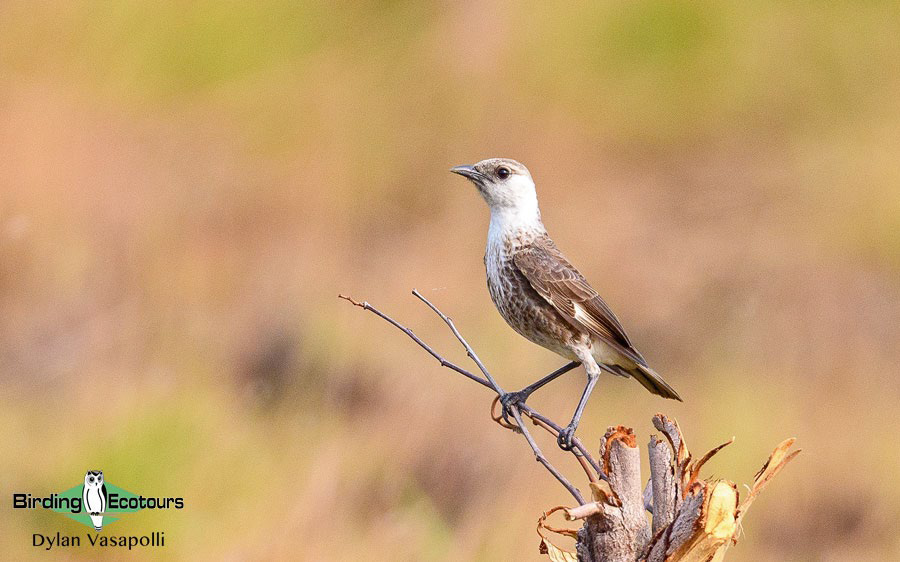
Congo Moor Chat is a localized species restricted to a difficult part of Africa to access – fortunately, they are common around the Lekoni area of Gabon.
We enjoyed a midday break during the heat of the day, before resuming in a different area west of town, where we would focus on miombo woodland birding. Birding in miombo woodland can be tricky at the best of times, and this afternoon was one of those difficult sessions. We were also plagued by some horrible tiny biting sand flies as we went about, which left us with bumps (and some blood) of varying degrees. A party of fidgety Green-capped Eremomelas showed well early on, but it took an exceedingly long time for all of us to get onto the scarce Yellow-bellied Hyliota – the birds were incredibly shy and would disappear almost as we picked up on them. A Flappet Lark buzzed overhead, noisy Striped Kingfishers perched atop some dead branches and a Dark Chanting Goshawk came flying through. We did well to latch onto a scarce Wood Pipit, as it was first displaying, and then perching for us. With the miombo mostly quiet, we tried our hand at some of the denser thickets found within and, while we heard some other targets like Bocage’s Bushshrike, we were unable to lay eyes on them. As the evening began drifting in, and our legs awash with bites, we called it a day, and retired back for dinner, after one of those “difficult” afternoons.
Day 7, 31st August 2024. Birding the Bongoville forest
After an early breakfast, we shot off to the productive lowland forests near Bongoville, a short distance away, where we would spend the morning birding. Although the birding is restricted to the roadside edge here, as the main road runs through the forest, you are right up against the treeline, making the birding excellent. Starting off on the forest edge, we quickly picked up the always spectacular Black Bee-eater, while Congo Pied Hornbills floated by noisily. A group of Rufous-bellied Helmetshrike flew by in the distance, but sadly not everyone got onto them before they disappeared out of sight. Swamp Palm Bulbuls were vocal and showed well in some of the large palm trees along the river. As we moved into the forest proper, a wide range of barbets showed in quick succession, with us enjoying everything from the bland Naked-faced Barbets to the bright Yellow-spotted Barbet and large Hairy-breasted Barbet, while the dainty Red-rumped and Yellow-throated Tinkerbirds were also about.
A massive group of Spotted Greenbuls kept us company for a while, numbering well over 50 birds, while a vocal Lyre-tailed Honeyguide sadly went by unseen, despite our best efforts – not unusual for this notoriously difficult-to-see species. A clearing at another river bridge gave us a flyby group of Purple-headed Starlings, along with several sunbirds, including Tiny, Blue-throated Brown and Little Green Sunbirds. A Cassin’s Malimbe also showed well, before a young African Harrier Hawk swooped in, and quietened things down a bit again. Despite Yellow-billed Turacos being rather vocal throughout the morning, we were unable to get any decent views and only saw distant and brief flight views as the birds crossed the road. The scarce Yellow-throated Cuckoo showed incredibly well however, and we even watched as it did its strange display on an exposed perch. The bird would call, angle its head straight up, and rapidly jump up and down on a branch while resuming with some excited calls. What a superb view of this scarce bird! A lovely gabonensis Black Cuckoo and Blue Malkoha also showed well, while Olive Long-tailed Cuckoo remained as a heard only species. We birded long and hard trying to find our main target, Black-headed Bee-eater, but sadly came up empty, and eventually called it in the late morning. A few opportunistic stops along the way back to Lekoni gave us some raptors like Bateleur and Red-necked Buzzard.
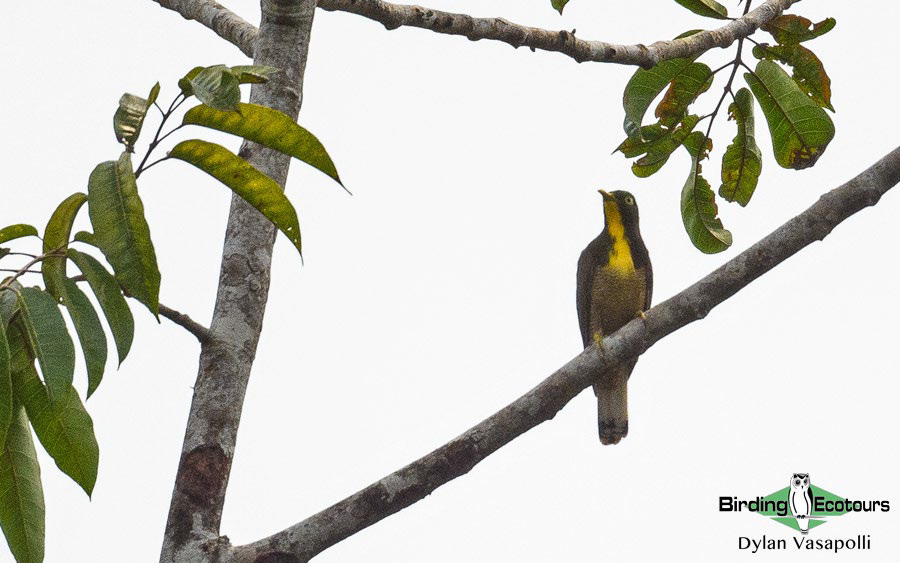
We had great sightings of the scarce Yellow-throated Cuckoo – and even watched as it performed its strange jumping display.
In the afternoon, we set out on foot from our accommodations to explore some of the nearby thicket habitat. Although much of it had been chopped out and burnt down in the days prior, as was evident with the recent ploughing, cutting and smoldering logs and brush piles still visible, we had a very birdy afternoon. We picked up on the likes of Brown-throated Wattle-eye, Black-and-white Shrike-flycatcher and White-chinned Prinia almost immediately and enjoyed views of them all. The distinct croaks of a Lühder’s Bushshrike drifted in, and we headed off closer to the call, before finding a lovely pair of these birds. Here, we also found a showy Bocage’s Bushshrike and a Sharpe’s Drongo. We headed off to explore another thicket area, and enjoyed the likes of both Klaas’s and Diederik Cuckoos, alongside other more widespread species like Little Bee-eater, Woodland Kingfisher, Yellow-rumped Tinkerbird and Cardinal Woodpecker, though the light was fading fast. We picked up on a calling African Broadbill, but, with the light now all but gone, had to be content with listening to the unique display of this bird. We then spent a short while enjoying a Bat Hawk flying around and chasing bats in the dim light.
Day 8, 1st September 2024. Long transfer to Makokou
With another full travel day lined up ahead of us, we departed our accommodations early, bound eventually for Makokou, well to the north. Like the roads in all of interior Gabon, they are grim and difficult to drive and make for a long and uncomfortable day. We had a few short birding stops on the way in the morning, as we tried to find our missing Black-headed Bee-eaters. At our last stop for them, we struck gold and found a few birds close to the road. Unlike most other members of this family, this is an incredibly inconspicuous species, and it took us a short while to get the looks we wanted, but we were well rewarded with great views of this highly sought-after bird! In the area, we also picked up on others like both Afep and Western Bronze-naped Pigeons, Blue-breasted Kingfisher, Black-winged Oriole, Red-eyed Puffback and a feisty party of Rufous-crowned Eremomelas. Progress was good, albeit slow, despite some vehicle issues – and we were all left somewhat baffled due to the apparent paucity of birds seen, despite the near pristine lowland forest we were driving through. We spent upwards of 8 hours driving through seemingly pristine forests and saw hardly any birds on the way. Closer to Makokou in the afternoon, we made a few more birding stops and enjoyed one particular stop at a river. Lovely White-bibbed Swallows flitted around, and a family of White-browed Forest-Flycatchers kept to the riverine trees, before we found the highly localized Gosling’s Apalis at point-blank range. We eventually rolled into Makokou with enough time for a rest, before settling in for the evening.
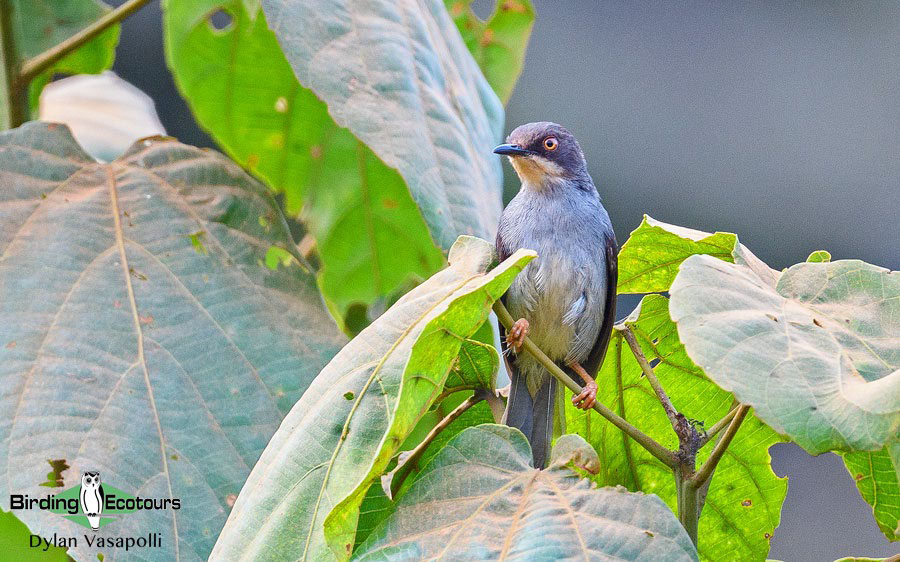
Not the most exciting-looking bird, this Gosling’s Apalis is a scarce, localized and sought-after special of this part of Africa.
Days 9 – 10, 2nd – 3rd September 2024. Birding the Ipassa-Makokou Strict Nature Reserve
The main reason for venturing up to this remote part of Gabon, is to visit the impressive forests found within the Ipassa-Makokou Strict Nature Reserve. This area is unique in that it is one of the few areas that birders can access lowland forest largely restricted to the mostly inaccessible Congo-basin – and all its scarce birds. As is always the case, forest birding can be difficult, and patience is always well rewarded. We spent two days birding within this area, and the days are discussed together below due to the similarity of the birding.
The sprawling research station grounds provide access to good forest edge birding, with many species coming right out into the open. Invariably the exposed branches at the treetops were occupied by African Green Pigeons and Piping Hornbills, while the massive Great Blue Turacos were surprisingly common and seen well and frequently in the upper canopies. Grey Parrots were delightfully common around the station and provided all of us with good views. Scarce birds like Yellow-throated and African Emerald Cuckoos were found perched high up, and we also did well to see the secretive Guinea Turaco. Red-eyed Puffbacks were commonly seen bounding around in the trees, and we also notched up others like Eastern Yellow-billed Barbet and Red-crowned Malimbe. The scrubby areas of thickets held onto shy birds like Speckled Tinkerbird, Yellow-browed and Olive-green Camaropteras, Green Hylia and Green Crombec, while some of the shaded areas delivered the sought-after White-bearded Greenbul. Moving away from the research grounds, the forests along the entrance road gave us a fine pair of Red-billed Dwarf Hornbills, while the massive White-thighed Hornbills gracefully flew low overhead. The thickets along the road produced further species like Western Nicator and the shy Yellow-lored Bristlebill, along with roving parties of Maxwell’s Black Weaver. We also did well to find the scarce Gabon Woodpecker, while others like African Piculet went by as heard only. Numbers of Square-tailed Saw-wings flitted about over any clearing. Various other forest species, including several barbets, sunbirds, greenbuls and flycatchers, were regularly encountered as well.
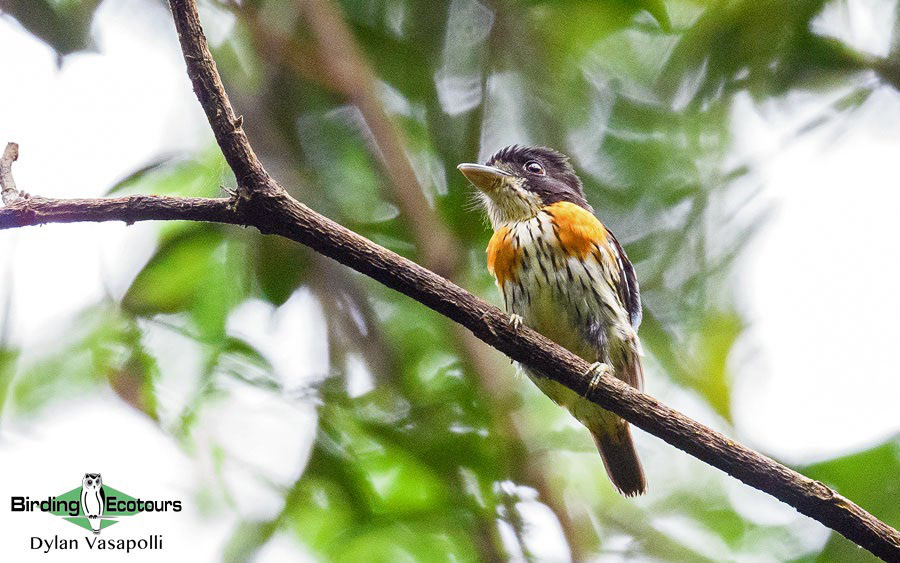
A fine Rufous-sided Broadbill about to launch into its display flight. We had incredible looks at this scarce forest bird.
Heading into the forest interior is the main event, and the forest bursts into life in between bouts of quiet. Groups of Spotted Greenbuls often signaled a bird wave coming through, and amongst these bird parties we picked up species like Western Oriole, Chestnut Wattle-eye, Bates’s Paradise Flycatcher, Buff-throated Apalis, Chestnut-capped Flycatcher and Cassin’s Malimbe, amongst others. Dense thickets gave up a fine Yellow-throated Nicator, while Dusky Crested Flycatcher showed briefly to only a few. A calling Chocolate-backed Kingfisher took a long while to track down (well spotted, John!), but once found, it showed remarkably well. Whilst we were painstakingly scanning for the kingfisher, we found a delightful pair of Rufous-sided Broadbills that put on an excellent show for us, before a shape flitting overhead led us to a small family group of shy Western Dwarf Hornbills. It took a little while before the birds settled, but we all eventually enjoyed good looks at these scarce birds. Indeed, the forest interior was good hornbill country, and we enjoyed further looks at the likes of Red-billed Dwarf Hornbill, hulking White-thighed Hornbill and numerous Congo Pied Hornbills. A pair of Yellow-crested Woodpeckers kept to the treetops, while an ant-swarm crossing the road gave us excellent views of the shy Fire-crested Alethe and White-tailed Ant-Thrush. Forest Robin remained unseen, despite several attempts to track this notorious skulker down, as did Brown Illadopsis. Other shy birds, like Pale-breasted Illadopsis,showed very well, while an African Dwarf Kingfisher that dashed across the road left us all wanting more. One of our other more hoped-for targets was Bare-cheeked Trogon, and we sadly had to make do with only hearing this species – the bird seemingly always one step ahead of us and remaining out of sight, despite our best efforts.
Birding in these forests is hard work, and it takes much patience and effort to track down the calling species. Our final afternoon, we settled in for a boat trip along the impressive Ipassa River. Although the birding was rather slow on the boat trip, somewhat surprisingly so, we did well, finding numerous Rock Pratincoles (including one flock that numbered roughly 100 birds!), a lone African Skimmer and some other riverine birds like African Fish Eagle, Hamerkop, Giant Kingfisher, Cassin’s Flycatcher and African Pied Wagtail. Around a wooded island we lucked onto a brief African Finfoot that soon disappeared before everyone could get onto it, and the final period with the sun going down gave us multiple Black-casqued and White-thighed Hornbills flying over the river, and a fine pair of Hartlaub’s Ducks shortly before we returned.
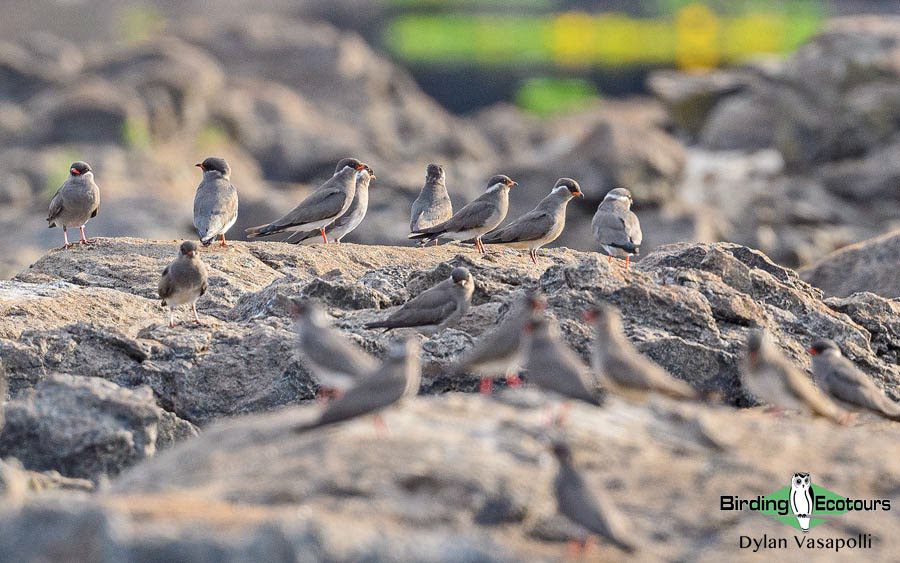
Just a small portion of the large Rock Pratincole flock seen on the Ipassa River.
Day 11, 4th September 2024. Long transfer back to Libreville
With another long travel day ahead of us, although mostly on paved roads this time, we set off in the early morning, bound ultimately for the capital city, Libreville, back on the coast. We forced in a few stops along the way, firstly at a productive swamp area. The birding was good, and the trees overlooking the swamp held onto Blue-throated Roller and Splendid Starling, amongst other species we had seen already, while the water held the likes of Hartlaub’s Duck, Black Crake, African Darter and Little Grebe. We also enjoyed the most incredible views of both Sabine’s and Cassin’s Spinetails drinking right in front of us – providing excellent comparative views. The surrounding areas were also full of birds and held the likes of Swamp Palm Bulbuls, Black-and-white Mannikins, Chattering Cisticola and several wonderful Purple-headed Starlings. The roads around here also gave us looks at Scaly Spurfowl and Western Bluebill for a lucky few. We eventually had to tear ourselves away and resume the journey. We broke for lunch in Ndjole once again (as on our first drive to Lopé NP), and scanned the river from a different area, and enjoyed far better views of the sought-after Grey Pratincoles than what we had previously. We rolled into Libreville in the late afternoon, and settled in.
Day 12, 5th September 2024. Flight to Port Gentil, and transfer to Loango National Park
Having survived the first part of the trip through the interior of Gabon, we were incredibly excited for the Loango National Park leg, and looking forward to more comfort and all the many exciting birds and mammals to come.
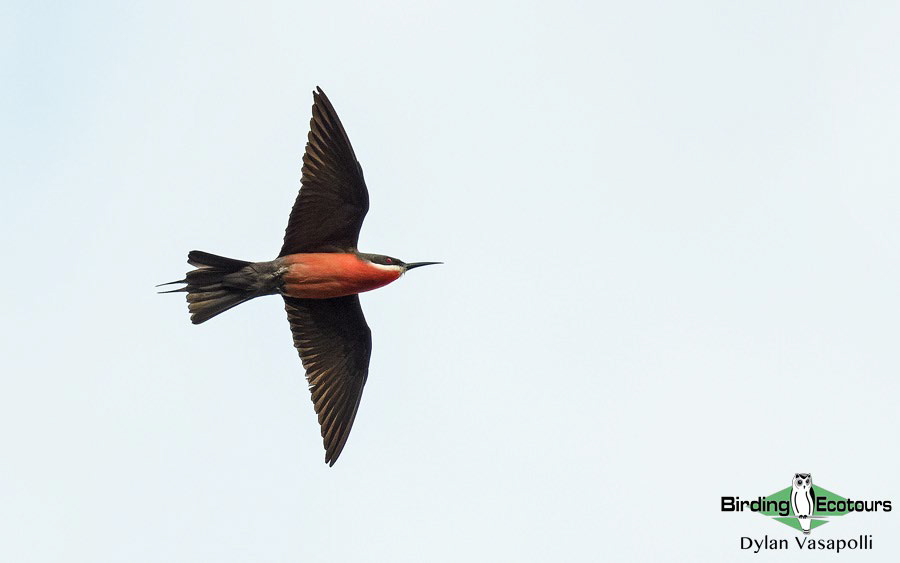
Delightful Rosy Bee-eaters proved to be very common around Loango.
We started the day off early, with a morning flight from Libreville down to Port Gentil. Here, we met up with our drivers and transferred by road down to Loango National Park – the roads here were in much better condition and made the driving a pleasure. A few stops on the way gave us mostly wetland birds like Caspian Tern, Squacco Heron and Pink-backed Pelican, though once we hit the beautiful coastal grasslands, we found the first of our many large Rosy Bee-eater flocks swooping about overhead. Once at the park, we booked in, before making our way over to the lovely Ndola Camp, where we had lunch and a short break. Eventually, we loaded up onto our boat and transferred deep into the park, bound for the Akaka Bush Camp, where we would spend two nights. The initial part of the boat ride was flat out, crossing the vast Iquela Lagoon, but once we turned off down the Akaka River, we slowed up and enjoyed a productive birding boat trip, all the way to the lodge. Kingfishers were bright and plentiful, with Pied, Malachite, Giant and Woodland Kingfishers all numerous and a shy Shining-blue Kingfisher seen. Some of the grassy floodplains adjacent to the otherwise forested banks held several other waterbirds like White-faced Whistling Duck, African Jacana, Yellow-billed Stork, Great Egret and Pink-backed Pelican. These open areas also gave us our first herd of African Forest Elephants. Rosy Bee-eaters were a dime a dozen, and seen almost continually along the way and we did well to locate a shy Mangrove Sunbird along the edge as well. Shortly before arriving at our camp, we noted some bee-eaters and spinetails drinking from the river in front of us, and we very quickly realized there were also several of the highly sought-after African River Martins present with them. We got some great views as they flew by right alongside us, red beaks and feet blindingly obvious, but it wasn’t until we found a perched flock of Rosy Bee-eaters that we truly saw them well – as in between the perched bee-eaters were quite a few African River Martins. Hardly believing our luck, we soaked up our views of this special bird, before going to check in at our comfortable lodge in this exquisite area.

We did very well to find the highly sought-after African River Martin on our first day in the area – with not many birds around during our trip.
Our check-in process was somewhat fragmented, as we had to carefully maneuver around the area because there were African Forest Elephants feeding in the camp. We all made it through safely and eventually started making our way back to the dining area for dinner – where we were treated to our first views of arguably the main birding attraction of the camp – the resident Vermiculated Fishing Owl. This rare bird is not only localized to remote and difficult-to-access habitat but is also notoriously hard to find and extremely shy. This beautiful camp, set in Gabon’s premier reserve, is easily the best place anywhere to locate this rare bird. Over the last few years, this rare bird has taken up roosting around the camp and is often sighted feeding from the surrounding trees – so much so that it has become slightly accustomed to people and is nowhere as shy as they generally are. It was with some disbelief that, when we came down to dinner, the bird was perched only a short distance away on the edge of the deck, totally unobstructed and unperturbed. Though it did eventually move on before everyone had come down to dinner this first evening, everyone would enjoy more views later in the night, and the following evening, leaving us all well and truly satisfied.
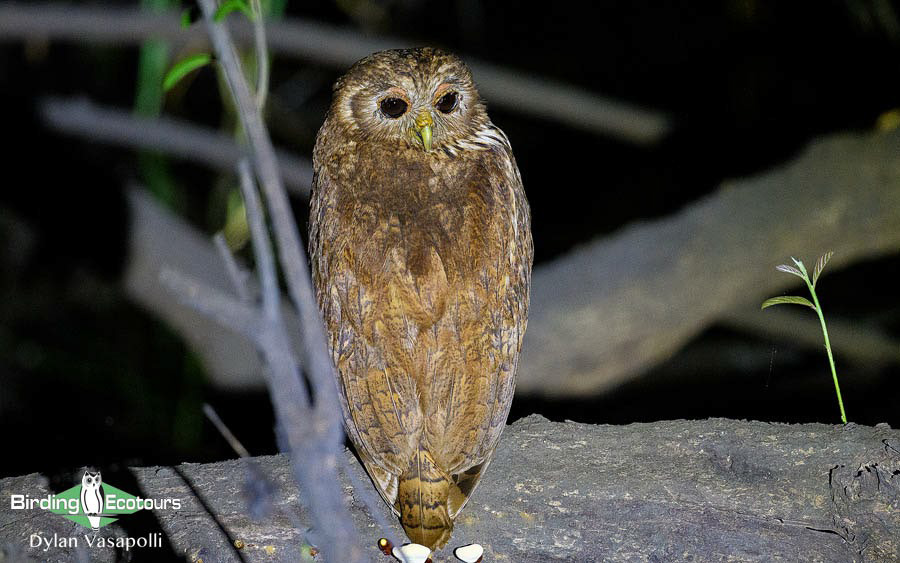
A rare view of a Vermiculated Fishing Owl. This must surely be the easiest spot to find this otherwise unknown and highly sought-after species!
Day 13, 6th September 2024. Birding the swamp forests of Akaka, Loango NP
Like the Mandrills in Lopé earlier in the trip, unique to our tour amongst other birding-focused tours, we also specifically include Western (Lowland) Gorilla trekking as part of the tour. Unlike in other countries like Uganda, where many folks can trek the Eastern (Mountain) Gorillas, the group size allowed to trek the animals here is a maximum of 4 clients – which meant we had to break our trekking up over two days to accommodate our group.
The first group set off for the trekking this morning, while the rest of us went out birding – focusing first on a nearby trail running through the forest. Before we even began, watching over the river from the dining deck produced a heap of birds, with numbers of waterbirds seen commuting up and down the channel, with the likes of multiple Purple Herons being new. Massive Black-casqued Hornbills were seen flying around in the early morning, before noisy Grey Parrots started their daily commutes. The forest walk was unfortunately slow, with bird activity largely absent. While we eked out a few birds like Brown-eared Woodpecker, Shining Drongo and Red-tailed Bristlebill, it was quiet going for the most part. Shortly before we arrived back at the boat, we heard the tell-tale hooting of a Bare-cheeked Trogon, and attempted to track it down once again (we had heard it a few days prior in the Ipassa-Makokou Strict Nature Reserve), but we were quickly halted as an African Forest Elephant came walking through and we had to beat a hasty retreat, putting paid to our attempts for this bird, unfortunately. A boat cruise followed, where we explored a quiet side channel, picking up a few more new birds like African Woolly-necked Stork, a fine African Cuckoo Hawk, African Pygmy Kingfisher and a rather showy Lowland Sooty Boubou. We eventually picked up on another of our target birds, Violet-tailed Sunbird, in the surrounding vegetation. We carefully followed the bird, and it led us to its nest, where it was busily building and adding material to it. Both Reichenbach’s and Carmelite Sunbirds showed well in addition to numerous Winding Cisticolas, amongst many others. We took it easy over the midday period, awaiting the return of the gorilla trekkers, and somewhat later than expected, they eventually arrived back, regaling us with tales of their experiences and time spent with the habituated Western Gorillas of Loango.
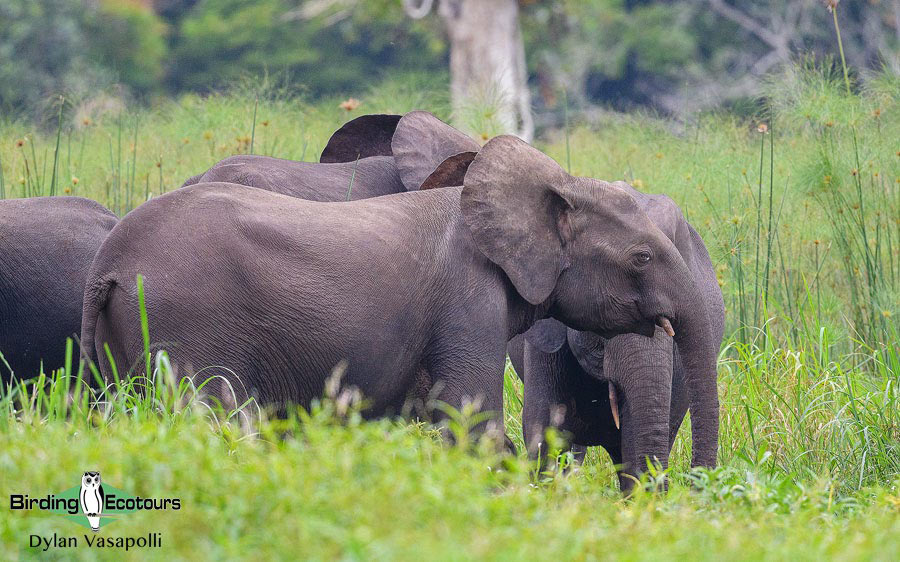
African Forest Elephants were regularly seen in the swampy areas around Akaka camp.
With the whole group together once more, we set off on a late afternoon boat cruise, heading deeper into the park. We had another superb cruise, with birds aplenty, and excellent looks at the scarce Central African Slender-snouted Crocodile, along with both Mustached and Putty-nosed Monkeys, along with the now ubiquitous African Forest Elephants feeding out on the floodplains. We spent some time watching a fine male African Finfoot swimming down the middle of the river, right next to the boat, until he veered off into the vegetation and clambered awkwardly into some low branches to sit next to his partner – the female perched inconspicuously nearby. A hulking Goliath Heron didn’t hang around for too long and we enjoyed repeat views of many other species, including multiple Cassin’s Flycatchers and White-bibbed Swallows. We also found large flocks of Red-headed Queleas moving about in the floodplain reaches and were able to track down both Violet-tailed and Reichenbach’s Sunbirds again. At dusk, we began heading back and stopped at a particular point to witness the most incredible spectacle of thousands of Rosy Bee-eaters performing the most incredible roosting display – swirling around in tight groups as they were coming down to roost in the trees surrounding the river. As if that wasn’t enough, we enjoyed good looks at the scarce White-backed Night Heron on the way back in the spotlight, and right on cue, our friendly Vermiculated Fishing Owl was back at camp!
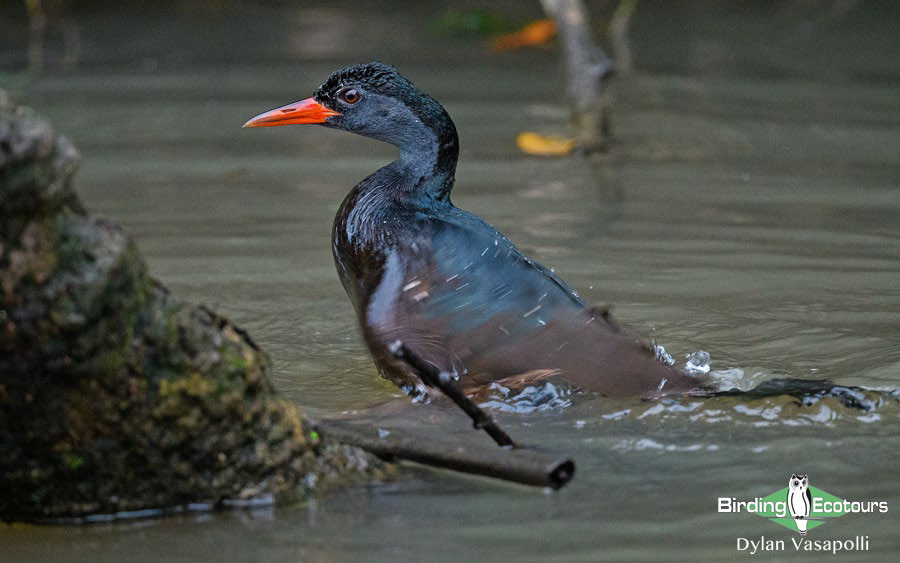
We spent some quality time watching a pair of African Finfoots – here, a fine male stretching his wings. The male finfoots in this area were all noticeably darker than other populations.
Day 14, 7th September 2024. Birding up to Ndola Camp in Loango NP
The groups were reversed this morning, with those that went gorilla trekking yesterday headed birding, and those that went birding yesterday headed for the gorillas. The restaurant deck was its usual busy self this morning, with many birds up and about. We also managed to finally bring in some of the sought-after Eastern Bearded Greenbuls that we regularly heard calling right in the camp. The morning walk through the forest today was much better, with more birds out and about. Early on in the walk we hit the jackpot, when a small group of the scarce Plumed Guineafowls crossed the pathway, giving us all excellent looks – but not for very long, before they scampered off into the dark undergrowth. Red-billed Dwarf Hornbills were present once more, and we spent a long while tracking down a vocal family of Eastern Long-tailed Hornbills (formerly part of the White-crested Hornbill group) – which resulted in us finally getting excellent views. We were also able to get some better views of Yellow-billed Turacos, as they came bounding through the treetops. Eventually, we came back out the forest and gathered our things together, as we would be checking out and heading onwards to Ndola Camp. With all our bags packed in the boat, we set off to join up with the gorilla trekkers and met them as they came out the forest, flushed with success from their encounter with these Great Apes. A stop off on the way, at an island in the vast Iguela Lagoon, gave us a few of the shy Loango Weavers, and a Swamp Boubou. We eventually checked in at Ndola Camp, enjoyed our lunch and a short break, before resuming in the afternoon.
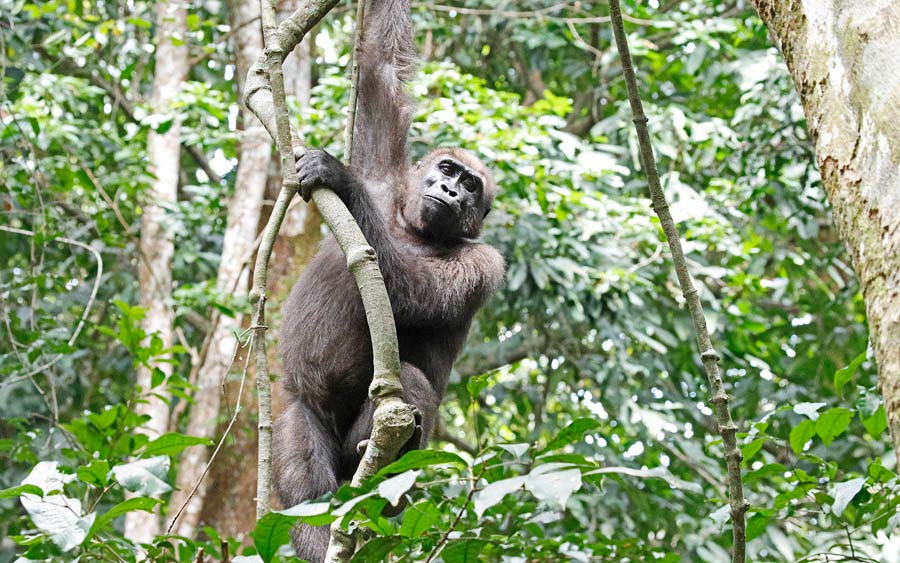
All the clients enjoyed spending time with the special Western (Lowland) Gorillas of Loango National Park. Photo © tour participant, Sue Bryan.
The afternoon would see us take a short boat ride to a landing, from where we would hop onto a safari vehicle and do a late afternoon safari drive. This was specifically done to take us through the more coastal grassland section of the park. It was a pleasure to be in this open habitat, for a change from forested areas. As we set about our drive, numbers of Long-legged Pipits and Yellow-throated Longclaws were seen walking through the short and recently burnt grasslands, while large numbers of swallows turned out to be mostly of the scarce Grey-rumped Swallows, with a few Banded Martins thrown in between. Stopping for a few close Senegal Lapwings also revealed a Kittlitz’s Plover, and shortly afterwards a fine pair of Forbes’s Plovers. Multiple Blue-breasted Bee-eaters were seen flitting about through the open habitat, and high numbers of Pectoral-patch Cisticolas were also noted. Another of our core targets was Red River Hog, and with the day running out, we did well to find not only one large family group, but two large family groups, roving about through the open areas. Although the hogs were a bit distant, we had excellent and extended views of the second large group.
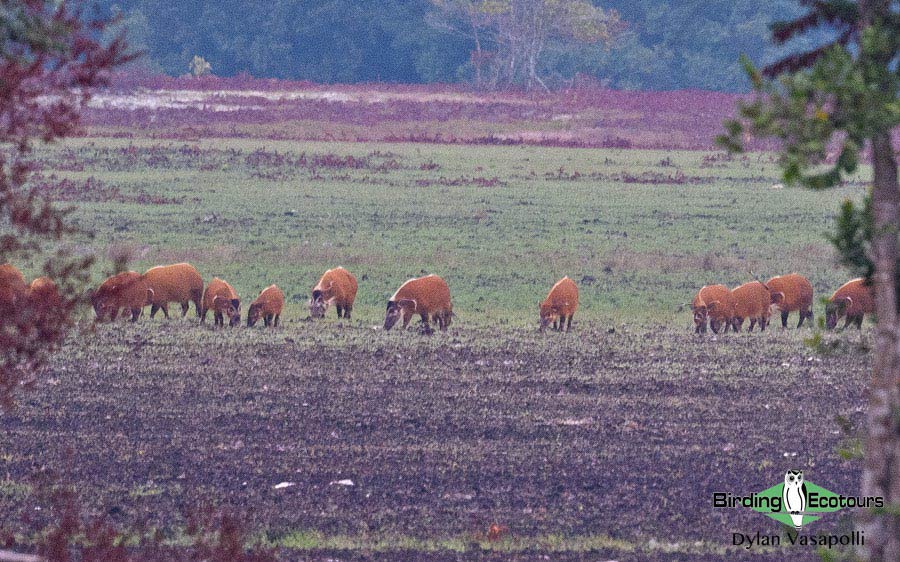
A large family of Red River Hogs foraging over the plains of Loango.
Day 15, 8th September 2024. Birding the open areas around Ndola Camp, Loango NP
Our morning started off with an early morning birding and safari drive through the open areas, straight out from the lodge this time. We did well to find a superb Black-headed Bee-eater early on, which gave us some excellent looks, and spent a while admiring some of the other species around, like Blue-spotted Wood Doves, Congo Pied Hornbills, Blue-breasted Bee-eaters and, on the large herds of Cape Buffalo, some fine Yellow-billed Oxpeckers. We scanned hard for birds we were missing, like Congo Serpent Eagle, but were not rewarded for our efforts. We called in at a Rosy Bee-eater colony and spent a long while enjoying close-up views of the birds perched in the surrounding trees, though we made sure to keep our distance from their specific nesting area. We enjoyed good scope views of the birds on the ground fixing up their nesting sites. Many species we had seen yesterday, like Forbes’s Plover and Grey-rumped Swallow, we found again today.
Following a good midday break, with lots of birds around the lodge, including Red-chested, Diederik and Klaas’s Cuckoos, Leaf-Loves and Green-headed, Reichenbach’s and Carmelite Sunbirds, we headed off for an afternoon adventure along the coast. This required a long and bumpy safari trip to a point on the beach, from where we set off on foot, and walked back to the lodge. There was little to see on the initial part of the drive, though once we set off on foot, we started picking up a few shorebirds which included everything from Grey and White-fronted Plovers, to Eurasian Whimbrel, Common Greenshank and Sanderlings. It also took a while but we eventually caught up with the tern roost at the mouth and, though the bulk of the numbers were comprised of Common Terns, we found others like Caspian, Sandwich and Black Terns, along with both of the sought-after Damara and West African Crested Terns. A large flock of African Skimmers had also gathered here and gave us fine views. The surrounding areas also delivered the likes of Western Reef Heron, Osprey, and somewhat strangely, several Malachite Kingfishers fishing on the beach.
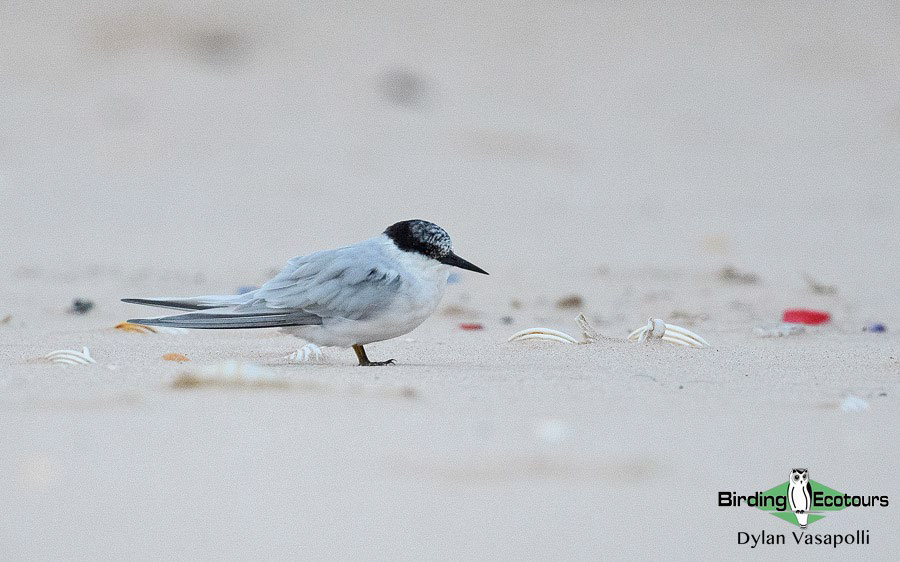
The tiny Damara Tern was a special bird found along the coast.
Day 16, 9th September 2024. Transfer from Loango NP back to Libreville
The penultimate day of the tour had arrived and would see us departing the lovely Ndola Camp fairly early on, bound for Omboue, where we would enjoy our final boat cruise, before eventually transferring back up to Port Gentil in time for our evening flight back to Libreville. Before we got going, we were able to enjoy a quick early morning birding walk around the lodge and surrounds. Here we made sure everyone got onto the resident Leaf-loves and also lucked out finding a nesting Square-tailed Nightjar. Eventually though, the time had come for us to load up, and we were soon back on the mainland, boarding our vehicles headed to Omboue. Once arrived, we checked in and quickly set off on our boat – which also involved a long trip out over a vast lagoon, to reach the quiet Mpivie River. This river is renowned in Gabon as being the only reliable place to find some further quality birds like White-crested Tiger Heron and Pel’s Fishing Owl.
As we set off down this small and densely forested river, numbers of Hartlaub’s Ducks were seen, and the numbers of African Finfoots around also increased dramatically. The likes of Giant Kingfisher, Cassin’s Flycatcher and White-bibbed Swallow were common, though we did enjoy several views of the jewel-like Shining-blue Kingfishers as well. Eventually, the distinct wing patterns of a White-crested Tiger Heron flashed across the river, and we stalked the bird on the bank through the vegetation. At times our views were obstructed, but we all got some good looks at this scarce bird. The owl was proving more challenging to find, and just as we were getting ready to give up and head back, we spotted a fine Pel’s Fishing Owl perched on a branch overhanding the river. Unfortunately, the bird didn’t hang around for very long and took flight deeper into the trees. We were able to track it down again, but the bird was extremely shy and soon flew off out of sight. Although we were hoping for better views, this was another important target species seen, and we high-tailed it back to Omboue. Progress was good on our return journey, and we called in at Cape Lopéz to wind up the last few hours before we had to be at the airport. Here a low-key beach walk was well enjoyed, with a number of terns and shorebirds seen again, with several hundred Damara Terns being the highlight. Our flight went smoothly, and we enjoyed our final evening dinner back at our comfortable Libreville hotel, reflecting on not only the trials and tribulations of doing a trip to Gabon, but all the many excellent and exciting birds we enjoyed on the way.
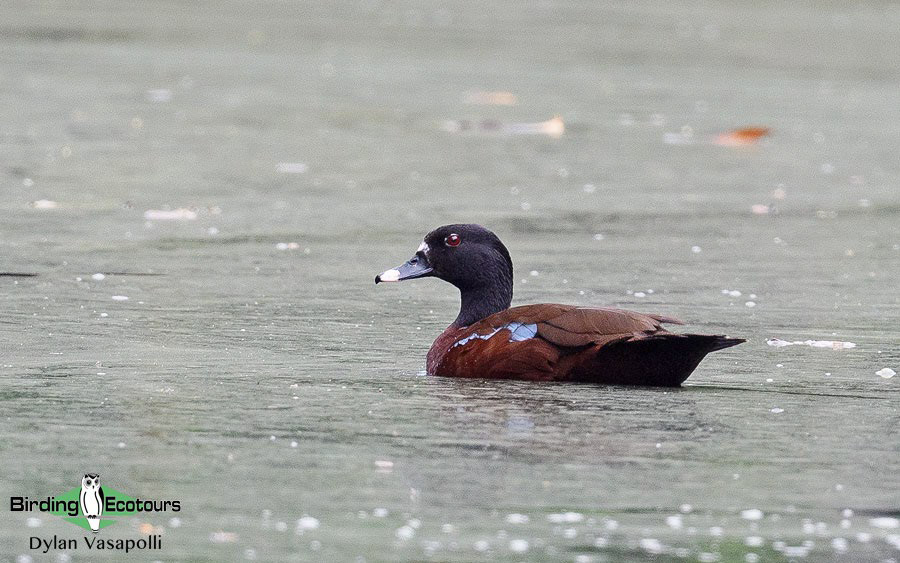
A Hartlaub’s Duck watches us from the Mpivie River.
Day 17, 10th September 2024. Departure from Libreville
The end of the tour had arrived, and the day was set aside for departures only, with no birding plans. We enjoyed a good breakfast together, before we all went our separate ways as we departed Gabon.
I would like to thank the group for always keeping their heads up, despite the challenging conditions and difficult nature of this tour. It was this, and the fantastic group camaraderie, that made the tour the success it was. Birding was all-round good, and we enjoyed views of many rare and sought-after birds and mammals.
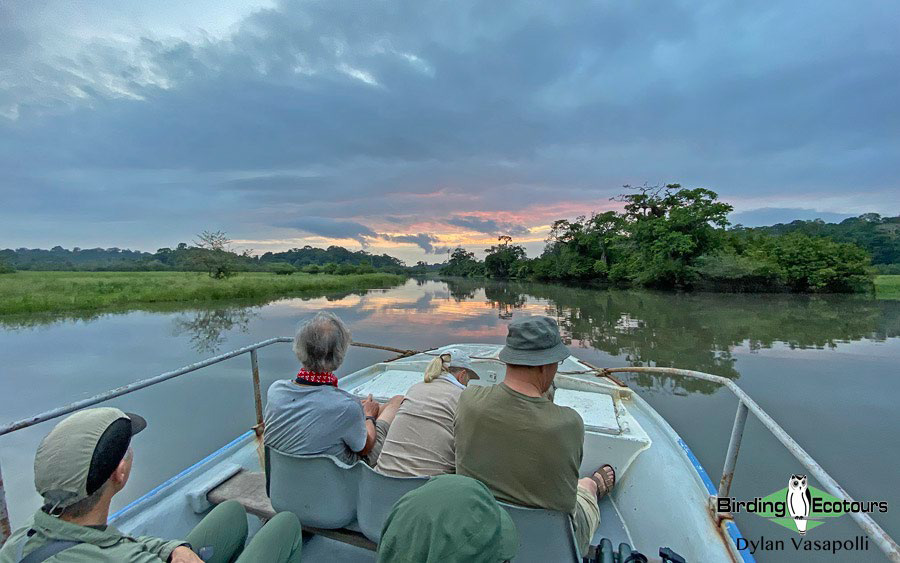
A view over the magnificent Loango National Park – surely Gabon’s most incredible park!
Bird List – Following IOC 14.2
Birds ‘heard only’ are marked with (H) after the common name, all other species were seen.
The following notation after species names is used to show conservation status following the IUCN Red List:
DD = Data Deficient, EN = Endangered, VU = Vulnerable.
| Common name | Scientific name |
| Ducks, Geese, Swans (Anatidae) | |
| White-faced Whistling Duck | Dendrocygna viduata |
| Hartlaub’s Duck | Pteronetta hartlaubii |
| Guineafowl (Numididae) | |
| Plumed Guineafowl | Guttera plumifera |
| Pheasants & Allies (Phasianidae) | |
| Scaly Spurfowl | Pternistis squamatus |
| Nightjars (Caprimulgidae) | |
| Swamp Nightjar | Caprimulgus natalensis |
| Bates’s Nightjar | Caprimulgus batesi |
| Square-tailed Nightjar | Caprimulgus fossii |
| Swifts (Apodidae) | |
| Mottled Spinetail | Telacanthura ussheri |
| Sabine’s Spinetail | Rhaphidura sabini |
| Cassin’s Spinetail | Neafrapus cassini |
| African Palm Swift | Cypsiurus parvus |
| Little Swift | Apus affinis |
| Horus Swift | Apus horus |
| White-rumped Swift | Apus caffer |
| Bates’s Swift | Apus batesi |
| Turacos (Musophagidae) | |
| Great Blue Turaco | Corythaeola cristata |
| Yellow-billed Turaco | Tauraco macrorhynchus |
| Guinea Turaco | Tauraco persa |
| Cuckoos (Cuculidae) | |
| Senegal Coucal | Centropus senegalensis |
| Blue-headed Coucal | Centropus monachus |
| Blue Malkoha | Ceuthmochares aereus |
| Diederik Cuckoo | Chrysococcyx caprius |
| Klaas’s Cuckoo | Chrysococcyx klaas |
| Yellow-throated Cuckoo | Chrysococcyx flavigularis |
| African Emerald Cuckoo | Chrysococcyx cupreus |
| Olive Long-tailed Cuckoo (H) | Cercococcyx olivinus |
| Black Cuckoo | Cuculus clamosus |
| Red-chested Cuckoo | Cuculus solitarius |
| Pigeons, Doves (Columbidae) | |
| Rock Dove | Columba livia |
| Afep Pigeon | Columba unicincta |
| Western Bronze-naped Pigeon | Columba iriditorques |
| Red-eyed Dove | Streptopelia semitorquata |
| Ring-necked Dove | Streptopelia capicola |
| Blue-spotted Wood Dove | Turtur afer |
| Tambourine Dove | Turtur tympanistria |
| Blue-headed Wood Dove | Turtur brehmeri |
| African Green Pigeon | Treron calvus |
| Finfoots (Heliornithidae) | |
| African Finfoot | Podica senegalensis |
| Rails, Crakes & Coots (Rallidae) | |
| Black Crake | Zapornia flavirostra |
| Grebes (Podicipedidae) | |
| Little Grebe | Tachybaptus ruficollis |
| Stone-curlews, Thick-knees (Burhinidae) | |
| Water Thick-knee | Burhinus vermiculatus |
| Plovers (Charadriidae) | |
| Grey Plover | Pluvialis squatarola |
| Forbes’s Plover | Charadrius forbesi |
| White-crowned Lapwing | Vanellus albiceps |
| Senegal Lapwing | Vanellus lugubris |
| Kittlitz’s Plover | Anarhynchus pecuarius |
| White-fronted Plover | Anarhynchus marginatus |
| Jacanas (Jacanidae) | |
| African Jacana | Actophilornis africanus |
| Sandpipers, Snipes (Scolopacidae) | |
| Eurasian Whimbrel | Numenius phaeopus |
| Common Sandpiper | Actitis hypoleucos |
| Wood Sandpiper | Tringa glareola |
| Common Greenshank | Tringa nebularia |
| Ruddy Turnstone | Arenaria interpres |
| Sanderling | Calidris alba |
| Coursers, Pratincoles (Glareolidae) | |
| Rock Pratincole | Glareola nuchalis |
| Grey Pratincole | Glareola cinerea |
| Gulls, Terns, Skimmers (Laridae) | |
| African Skimmer | Rynchops flavirostris |
| Damara Tern | Sternula balaenarum |
| Caspian Tern | Hydroprogne caspia |
| Black Tern | Chlidonias niger |
| Arctic Tern | Sterna paradisaea |
| Common Tern | Sterna hirundo |
| Sandwich Tern | Thalasseus sandvicensis |
| West African Crested Tern | Thalasseus albididorsalis |
| Storks (Ciconiidae) | |
| Yellow-billed Stork | Mycteria ibis |
| African Woolly-necked Stork | Ciconia microscelis |
| Anhingas, Darters (Anhingidae) | |
| African Darter | Anhinga rufa |
| Cormorants, Shags (Phalacrocoracidae) | |
| Reed Cormorant | Microcarbo africanus |
| Ibises, Spoonbills (Threskiornithidae) | |
| Hadada Ibis | Bostrychia hagedash |
| Herons, Bitterns (Ardeidae) | |
| White-crested Tiger Heron | Tigriornis leucolopha |
| Little Egret | Egretta garzetta |
| Western Reef Heron | Egretta gularis |
| White-backed Night Heron | Calherodius leuconotus |
| Squacco Heron | Ardeola ralloides |
| Great Egret | Ardea alba |
| Western Cattle Egret | Ardea ibis |
| Grey Heron | Ardea cinerea |
| Purple Heron | Ardea purpurea |
| Goliath Heron | Ardea goliath |
| Hamerkop (Scopidae) | |
| Hamerkop | Scopus umbretta |
| Pelicans (Pelecanidae) | |
| Pink-backed Pelican | Pelecanus rufescens |
| Ospreys (Pandionidae) | |
| Osprey | Pandion haliaetus |
| Kites, Hawks, Eagles (Accipitridae) | |
| African Harrier-Hawk | Polyboroides typus |
| Palm-nut Vulture | Gypohierax angolensis |
| European Honey Buzzard | Pernis apivorus |
| African Cuckoo-Hawk | Aviceda cuculoides |
| Bateleur – EN | Terathopius ecaudatus |
| Bat Hawk | Macheiramphus alcinus |
| Crowned Eagle | Stephanoaetus coronatus |
| Lizard Buzzard | Kaupifalco monogrammicus |
| Dark Chanting Goshawk | Melierax metabates |
| Red-thighed Sparrowhawk | Tachyspiza erythropus |
| Black Sparrowhawk | Astur melanoleucus |
| Yellow-billed Kite | Milvus aegyptius |
| African Fish Eagle | Icthyophaga vocifer |
| Red-necked Buzzard | Buteo auguralis |
| Owls (Strigidae) | |
| Pel’s Fishing Owl | Scotopelia peli |
| Vermiculated Fishing Owl | Scotopelia bouvieri |
| Trogons (Trogonidae) | |
| Bare-cheeked Trogon (H) | Apaloderma aequatoriale |
| Hornbills (Bucerotidae) | |
| Congo Pied Hornbill | Lophoceros fasciatus |
| Red-billed Dwarf Hornbill | Lophoceros camurus |
| Piping Hornbill | Bycanistes fistulator |
| White-thighed Hornbill | Bycanistes albotibialis |
| Black-casqued Hornbill | Ceratogymna atrata |
| Western Dwarf Hornbill | Horizocerus hartlaubi |
| Eastern Long-tailed Hornbill | Horizocerus cassini |
| Rollers (Coraciidae) | |
| Blue-throated Roller | Eurystomus gularis |
| Kingfishers (Alcedinidae) | |
| Chocolate-backed Kingfisher | Halcyon badia |
| Grey-headed Kingfisher | Halcyon leucocephala |
| Brown-hooded Kingfisher | Halcyon albiventris |
| Striped Kingfisher | Halcyon chelicuti |
| Blue-breasted Kingfisher | Halcyon malimbica |
| Woodland Kingfisher | Halcyon senegalensis |
| African Dwarf Kingfisher (H) | Ispidina lecontei |
| African Pygmy Kingfisher | Ispidina picta |
| White-bellied Kingfisher | Corythornis leucogaster |
| Malachite Kingfisher | Corythornis cristatus |
| Shining-blue Kingfisher | Alcedo quadribrachys |
| Giant Kingfisher | Megaceryle maxima |
| Pied Kingfisher | Ceryle rudis |
| Bee-eaters (Meropidae) | |
| Black-headed Bee-eater | Merops breweri |
| Blue-headed Bee-eater | Merops muelleri |
| Black Bee-eater | Merops gularis |
| Little Bee-eater | Merops pusillus |
| Blue-breasted Bee-eater | Merops variegatus |
| White-fronted Bee-eater | Merops bullockoides |
| White-throated Bee-eater | Merops albicollis |
| Rosy Bee-eater | Merops malimbicus |
| African Barbets (Lybiidae) | |
| Eastern Yellow-billed Barbet | Trachyphonus purpuratus |
| Grey-throated Barbet | Gymnobucco bonapartei |
| Naked-faced Barbet | Gymnobucco calvus |
| Speckled Tinkerbird | Pogoniulus scolopaceus |
| Red-rumped Tinkerbird | Pogoniulus atroflavus |
| Yellow-throated Tinkerbird | Pogoniulus subsulphureus |
| Yellow-rumped Tinkerbird | Pogoniulus bilineatus |
| Yellow-spotted Barbet | Buccanodon duchaillui |
| Hairy-breasted Barbet | Tricholaema hirsuta |
| Honeyguides (Indicatoridae) | |
| Lyre-tailed Honeyguide (H) | Melichneutes robustus |
| Woodpeckers (Picidae) | |
| African Piculet (H) | Verreauxia africana |
| Brown-eared Woodpecker | Pardipicus caroli |
| Little Green Woodpecker | Campethera maculosa |
| Yellow-crested Woodpecker | Chloropicus xantholophus |
| Cardinal Woodpecker | Dendropicos fuscescens |
| Gabon Woodpecker | Dendropicos gabonensis |
| African & New World Parrots (Psittacidae) | |
| Grey Parrot – EN | Psittacus erithacus |
| African & Green Broadbills (Calyptomenidae) | |
| Rufous-sided Broadbill | Smithornis rufolateralis |
| African Broadbill (H) | Smithornis capensis |
| Wattle-eyes, Batises (Platysteiridae) | |
| Western Black-headed Batis | Batis erlangeri |
| Chestnut Wattle-eye | Platysteira castanea |
| Brown-throated Wattle-eye | Platysteira cyanea |
| Bushshrikes (Malaconotidae) | |
| Fiery-breasted Bushshrike (H) | Malaconotus cruentus |
| Bocage’s Bushshrike | Chlorophoneus bocagei |
| Brown-crowned Tchagra (H) | Tchagra australis |
| Black-crowned Tchagra (H) | Tchagra senegalus |
| Red-eyed Puffback | Dryoscopus senegalensis |
| Lowland Sooty Boubou | Laniarius leucorhynchus |
| Lühder’s Bushshrike | Laniarius luehderi |
| Swamp Boubou | Laniarius bicolor |
| Vangas & Allies (Vangidae) | |
| Rufous-bellied Helmetshrike | Prionops rufiventris |
| Black-and-white Shrike-flycatcher | Bias musicus |
| Figbirds, Old World Orioles, Piopios (Oriolidae) | |
| Western Oriole | Oriolus brachyrynchus |
| Black-winged Oriole | Oriolus nigripennis |
| Drongos (Dicruridae) | |
| Velvet-mantled Drongo | Dicrurus modestus |
| Fork-tailed Drongo | Dicrurus adsimilis |
| Shining Drongo | Dicrurus atripennis |
| Sharpe’s Drongo | Dicrurus sharpei |
| Monarchs (Monarchidae) | |
| Rufous-vented Paradise Flycatcher | Terpsiphone rufocinerea |
| Bates’s Paradise Flycatcher | Terpsiphone batesi |
| African Paradise Flycatcher | Terpsiphone viridis |
| Shrikes (Laniidae) | |
| Northern Fiscal | Lanius humeralis |
| Crows, Jays (Corvidae) | |
| Pied Crow | Corvus albus |
| Fairy Flycatchers (Stenostiridae) | |
| Dusky Crested Flycatcher (H) | Elminia nigromitrata |
| Tits, Chickadees (Paridae) | |
| White-winged Black Tit | Melaniparus leucomelas |
| Nicators (Nicatoridae) | |
| Western Nicator | Nicator chloris |
| Yellow-throated Nicator | Nicator vireo |
| Larks (Alaudidae) | |
| Flappet Lark | Amirafra rufocinnamomea |
| Plains Lark | Corypha kabalii |
| Bulbuls (Pycnonotidae) | |
| Slender-billed Greenbul | Stelgidillas gracilirostris |
| Golden Greenbul | Calyptocichla serinus |
| Black-collared Bulbul | Neolestes torquatus |
| Red-tailed Bristlebill | Bleda syndactylus |
| Yellow-lored Bristlebill | Bleda notatus |
| Pale-throated Greenbul | Atimastillas flavigula |
| Spotted Greenbul | Ixonotus guttatus |
| Swamp Palm Bulbul | Thescelocichla leucopleura |
| Simple Greenbul | Chlorocichla simplex |
| Honeyguide Greenbul | Baeopogon indicator |
| Eastern Bearded Greenbul | Criniger chloronotus |
| White-bearded Greenbul | Criniger ndussumensis |
| Little Greenbul | Eurillas virens |
| Yellow-whiskered Greenbul | Eurillas latirostris |
| Plain Greenbul | Eurillas curvirostris |
| Little Grey Greenbul | Eurillas gracilis |
| Ansorge’s Greenbul | Eurillas ansorgei |
| Leaf-love | Phyllastrephus scandens |
| Common Bulbul | Pycnonotus barbatus |
| Swallows, Martins (Hirundinidae) | |
| African River Martin – DD | Pseudochelidon eurystomina |
| Square-tailed Saw-wing | Psalidoprocne nitens |
| Black Saw-wing | Psalidoprocne pristoptera |
| Grey-rumped Swallow | Pseudhirundo griseopyga |
| Banded Martin | Neophedina cincta |
| Barn Swallow | Hirundo rustica |
| Ethiopian Swallow | Hirundo aethiopica |
| Angola Swallow | Hirundo angolensis |
| White-bibbed Swallow | Hirundo nigrita |
| Forest Swallow | Atronanus fuliginosus |
| Lesser Striped Swallow | Cecropis abyssinica |
| Red-breasted Swallow | Cecropis semirufa |
| Red-throated Cliff Swallow | Petrochelidon rufigula |
| Crombecs, African Warblers (Macrosphenidae) | |
| Yellow Longbill (H) | Macrosphenus flavicans |
| Grey Longbill (H) | Macrosphenus concolor |
| Green Crombec | Sylvietta virens |
| Yellow Flycatchers (Erythrocercidae) | |
| Chestnut-capped Flycatcher | Erythrocercus mccallii |
| Hylias (Hyliidae) | |
| Green Hylia | Hylia prasina |
| Grassbirds & Allies (Locustellidae) | |
| Dja River Scrub Warbler | Bradypterus grandis |
| Cisticolas & Allies (Cisticolidae) | |
| Chattering Cisticola | Cisticola anonymus |
| Tinkling Cisticola | Cisticola rufilatus |
| Winding Cisticola | Cisticola marginatus |
| Croaking Cisticola | Cisticola natalensis |
| Short-winged Cisticola | Cisticola brachypterus |
| Zitting Cisticola | Cisticola juncidis |
| Pectoral-patch Cisticola | Cisticola brunnescens |
| Tawny-flanked Prinia | Prinia subflava |
| Banded Prinia (H) | Prinia bairdii |
| White-chinned Prinia | Schistolais leucopogon |
| Buff-throated Apalis | Apalis rufogularis |
| Gosling’s Apalis | Apalis goslingi |
| Grey-backed Camaroptera | Camaroptera brevicaudata |
| Yellow-browed Camaroptera | Camaroptera superciliaris |
| Olive-green Camaroptera | Camaroptera chloronota |
| Green-capped Eremomela | Eremomela scotops |
| Rufous-crowned Eremomela | Eremomela badiceps |
| Ground Babblers (Pellorneidae) | |
| Brown Illadopsis (H) | Illadopsis fulvescens |
| Pale-breasted Illadopsis | Illadopsis rufipennis |
| Hyliotas (Hyliotidae) | |
| Yellow-bellied Hyliota | Hyliota flavigaster |
| Starlings, Rhabdornises (Sturnidae) | |
| Purple-headed Starling | Hylopsar purpureiceps |
| Splendid Starling | Lamprotornis splendidus |
| Violet-backed Starling | Cinnyricinclus leucogaster |
| Chestnut-winged Starling | Onychognathus fulgidus |
| Oxpeckers (Buphagidae) | |
| Yellow-billed Oxpecker | Buphagus africanus |
| Thrushes (Turdidae) | |
| Fraser’s Rufous Thrush | Stizorhina fraseri |
| White-tailed Ant Thrush | Neocossyphus poensis |
| African Thrush | Turdus pelios |
| Chats, Old World Flycatchers (Muscicapidae) | |
| Fire-crested Alethe | Alethe castanea |
| White-browed Scrub Robin (H) | Cercotrichas leucophrys |
| White-browed Forest Flycatcher | Fraseria cinerascens |
| Fraser’s Forest Flycatcher | Fraseria ocreata |
| Dusky-blue Flycatcher | Bradornis comitatus |
| Sooty Flycatcher | Bradornis fuliginosus |
| Little Grey Flycatcher | Muscicapa epulata |
| Cassin’s Flycatcher | Muscicapa cassini |
| Forest Robin (H) | Stiphrornis erythrothorax |
| Congo Moor Chat | Myrmecocichla tholloni |
| Sooty Chat | Myrmecocichla nigra |
| Sunbirds (Nectariniidae) | |
| Mangrove Sunbird | Anthreptes gabonicus |
| Violet-tailed Sunbird | Anthreptes aurantius |
| Little Green Sunbird | Anthreptes seimundi |
| Grey-chinned Sunbird | Anthreptes tephrolaemus |
| Collared Sunbird | Hedydipna collaris |
| Reichenbach’s Sunbird | Anabathmis reichenbachii |
| Green-headed Sunbird | Cyanomitra verticalis |
| Blue-throated Brown Sunbird | Cyanomitra cyanolaema |
| Olive Sunbird | Cyanomitra olivacea |
| Carmelite Sunbird | Chalcomitra fuliginosa |
| Green-throated Sunbird | Chalcomitra rubescens |
| Olive-bellied Sunbird | Cinnyris chloropygius |
| Tiny Sunbird | Cinnyris minullus |
| Johanna’s Sunbird | Cinnyris johannae |
| Superb Sunbird | Cinnyris superbus |
| Copper Sunbird | Cinnyris cupreus |
| Old World Sparrows, Snowfinches (Passeridae) | |
| Yellow-throated Bush Sparrow | Gymnoris superciliaris |
| Northern Grey-headed Sparrow | Passer griseus |
| House Sparrow | Passer domesticus |
| Weavers, Widowbirds (Ploceidae) | |
| Black-chinned Weaver | Ploceus nigrimentus |
| Slender-billed Weaver | Ploceus pelzelni |
| Loango Weaver – VU | Ploceus subpersonatus |
| Black-necked Weaver | Ploceus nigricollis |
| Orange Weaver | Ploceus aurantius |
| Village Weaver | Ploceus cucullatus |
| Vieillot’s Black Weaver | Ploceus nigerrimus |
| Yellow-mantled Weaver | Ploceus tricolor |
| Maxwell’s Black Weaver | Ploceus albinucha |
| Compact Weaver | Ploceus superciliosus |
| Red-crowned Malimbe | Malimbus coronatus |
| Cassin’s Malimbe | Malimbus cassini |
| Blue-billed Malimbe | Malimbus nitens |
| Red-headed Quelea | Quelea erythrops |
| Yellow-mantled Widowbird | Euplectes macroura |
| Waxbills, Munias & Allies (Estrildidae) | |
| Bronze Mannikin | Spermestes cucullata |
| Black-and-white Mannikin | Spermestes bicolor |
| White-breasted Nigrita | Nigrita fusconotus |
| Chestnut-breasted Nigrita (H) | Nigrita bicolor |
| Grey-headed Nigrita | Nigrita canicapillus |
| Black-headed Waxbill | Estrilda atricapilla |
| Orange-cheeked Waxbill | Estrilda melpoda |
| Fawn-breasted Waxbill | Estrilda paludicola |
| Common Waxbill | Estrilda astrild |
| Western Bluebill | Spermophaga haematina |
| Indigobirds, Whydahs (Viduidae) | |
| Pin-tailed Whydah | Vidua macroura |
| Wagtails, Pipits (Motacillidae) | |
| African Pied Wagtail | Motacilla aguimp |
| Yellow-throated Longclaw | Macronyx croceus |
| Wood Pipit | Anthus nyassae |
| Long-legged Pipit | Anthus pallidiventris |
| Short-tailed Pipit | Anthus brachyurus |
| Finches, Euphonias (Fringillidae) | |
| Black-faced Canary | Crithagra capistrata |
| Buntings (Emberizidae) | |
| Cabanis’s Bunting | Emberiza cabanisi |
| Species seen: | 288 |
| Species heard: | 18 |
| Total recorded: | 306 |
Mammal List – Following Mammalwatching.com (Jan 2024)
Mammals ‘heard only’ are marked with (H) after the common name, all other species were seen.
The following notation after species names is used to show conservation status following the IUCN Red List:
CR = Critically Endangered, EN = Endangered, VU = Vulnerable.
| Common name | Scientific name |
| Elephants (Elephantidae) | |
| African Forest Elephant – CR | Loxodonta cyclotis |
| Old World Monkeys (Cercopithecidae) | |
| Mustached Monkey | Cercopithecus cephus |
| Putty-nosed Monkey | Cercopithecus nictitans |
| Red-capped Mangabey – EN | Cercocebus torquatus |
| Gray-cheeked Mangabey – VU | Lophocebus albigena |
| Mandrill – VU | Mandrillus sphinx |
| Black Colobus – VU | Colobus satanas |
| Great Apes (Hominidae) | |
| Western Gorilla – CR | Gorilla gorilla |
| Old World Fruit Bats (Pteropodidae) | |
| African Straw-colored Fruit Bat | Eidolon helvum |
| Bovids (Bovidae) | |
| Bay Duiker | Cephalophus dorsalis |
| Blue Duiker | Philantomba monticola |
| Cape Buffalo | Syncerus caffer |
| Suids (Suidae) | |
| Red River Hog | Potamochoerus porcus |
| Hippopotamuses (Hippopotamidae) | |
| Common Hippopotamus – VU | Hippopotamus amphibius |
| Species seen: | 14 |
Reptile List
| Common name | Scientific name |
| Crocodiles (Crocodylidae) | |
| Nile Crocodile | Crocodylus niloticus |
| Central African Slender-snouted crocodile | Mecistops leptorhynchus |
| Dragons (Agamidae) | |
| Peters’s Rock Agama | Agama picticauda |
| Typical Geckos (Gekkonidae) | |
| Tropical House Gecko | Hemidactylus mabouia |
| Monitor Lizards (Varanidae) | |
| Nile Monitor | Varanus niloticus |
| Species seen: | 5 |
DOWNLOAD TRIP REPORT
This is a sample trip report. Please email us ([email protected]) for more trip reports from this destination.
Do you want to see hundreds of Rosy Bee-eaters lighting up a tree as if it was an illuminated Christmas Tree? Then this is the tour for you! Gabon offers a wonderful spectacle of a murmuration of hundreds of Rosy Bee-eaters going to roost at dusk, whilst you sit back in the warmth of an African evening in a boat slowly cruising down the river before drawing into your riverside lodge where you will overlook the Gabon forest as it goes to sleep for the night.
Enjoy the Lowland Gorillas as they enchant you with their sounds and youngsters playfulness, after you have trekked along an elephant trail after alighting from your boat at a Gorilla research station whilst listening out for the approach of Forest Elephants along the way!
